Leadership and Management in Operations Management: A Comparative Analysis
VerifiedAdded on 2024/05/17
|26
|5141
|360
AI Summary
This report explores the distinct roles and characteristics of leaders and managers within the context of operations management. It examines how leadership styles, such as situational leadership, systems leadership, and contingency theory, influence organizational effectiveness. The report also delves into key operations management approaches, including business process re-engineering (BPR) and lean manufacturing, highlighting their impact on achieving business objectives. Furthermore, it analyzes various environmental factors that impact operational management and decision-making by leaders and managers, including organizational culture, labor efficiency, technological changes, and social responsibility issues.
Contribute Materials
Your contribution can guide someone’s learning journey. Share your
documents today.
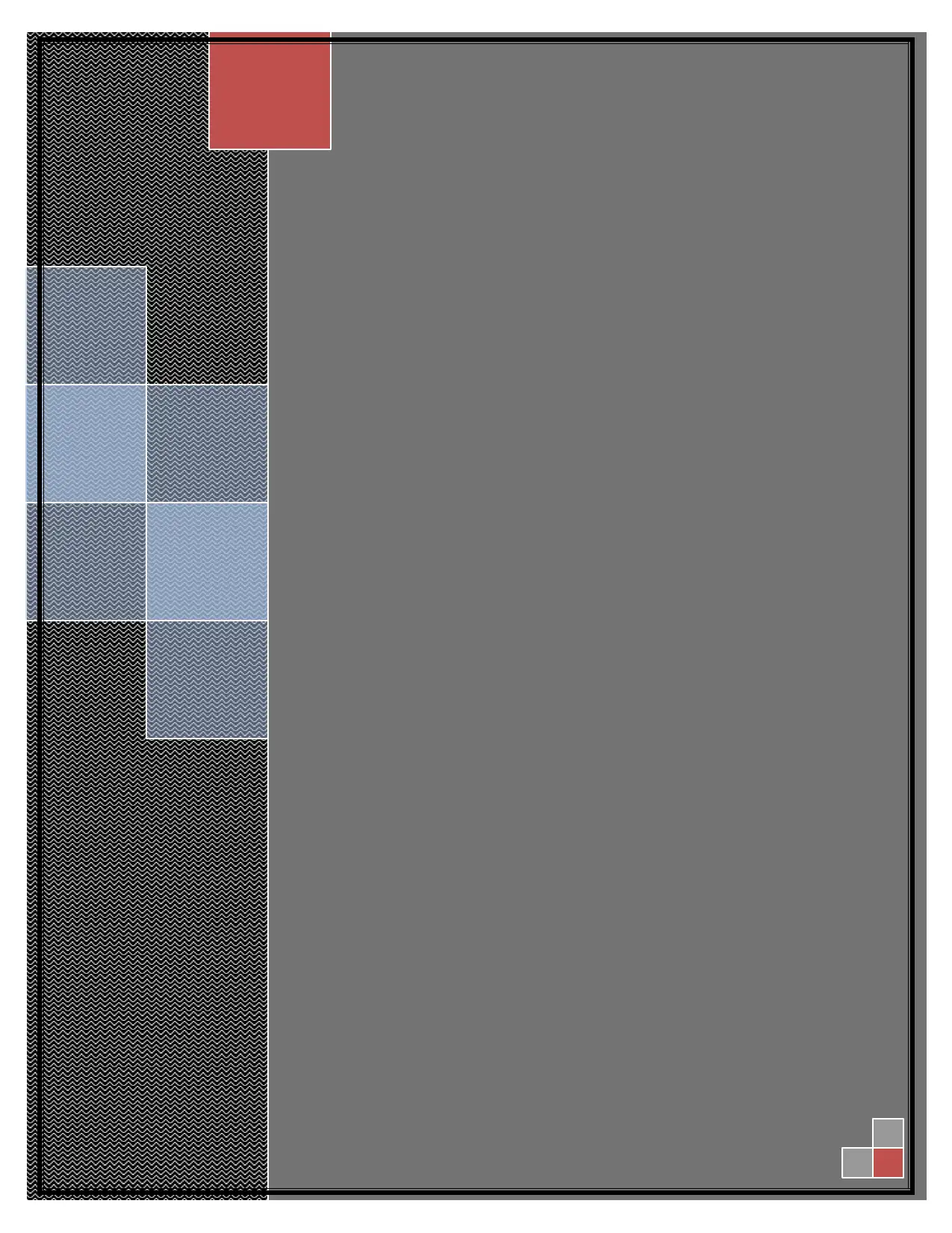
Secure Best Marks with AI Grader
Need help grading? Try our AI Grader for instant feedback on your assignments.
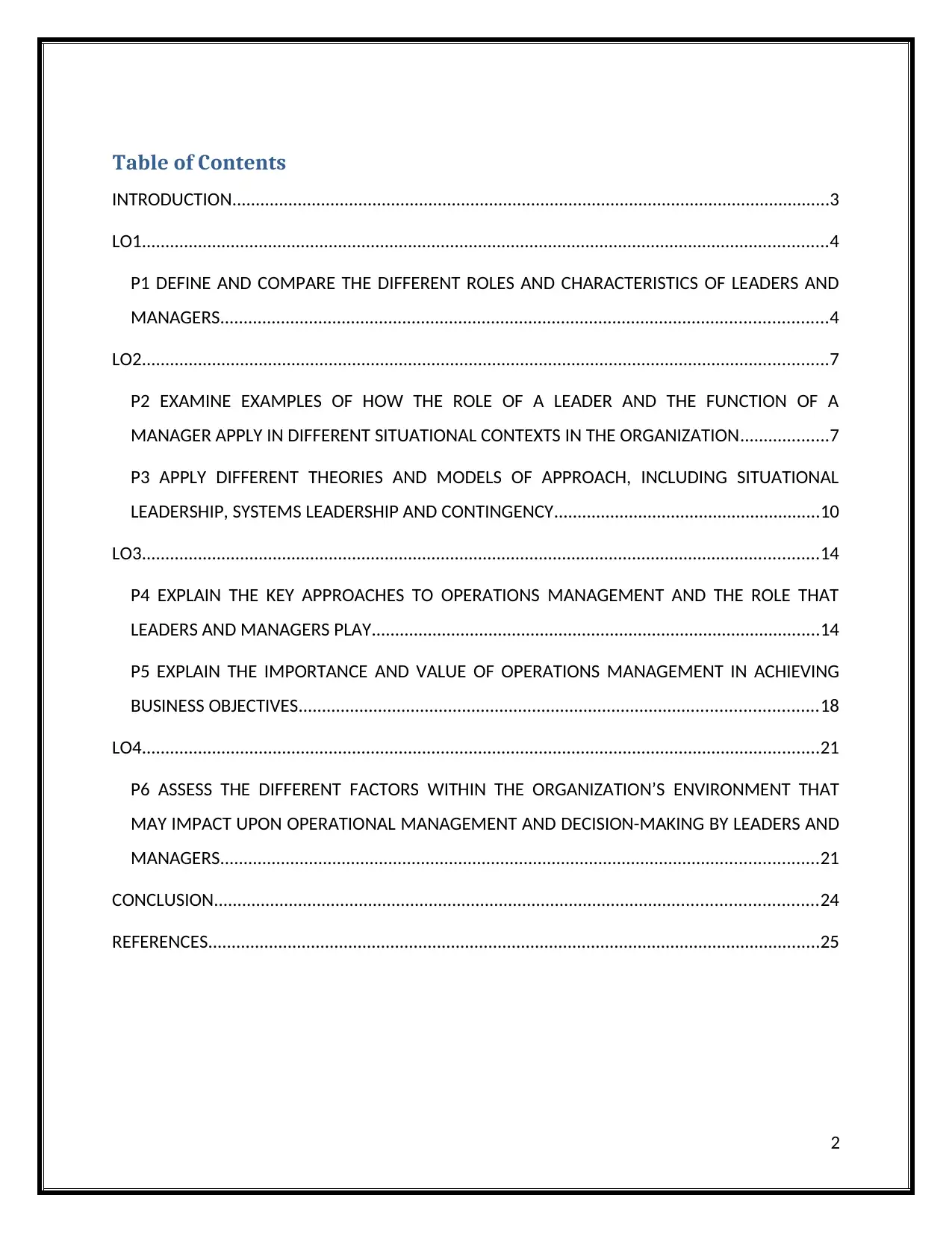
Table of Contents
INTRODUCTION................................................................................................................................3
LO1...................................................................................................................................................4
P1 DEFINE AND COMPARE THE DIFFERENT ROLES AND CHARACTERISTICS OF LEADERS AND
MANAGERS..................................................................................................................................4
LO2...................................................................................................................................................7
P2 EXAMINE EXAMPLES OF HOW THE ROLE OF A LEADER AND THE FUNCTION OF A
MANAGER APPLY IN DIFFERENT SITUATIONAL CONTEXTS IN THE ORGANIZATION...................7
P3 APPLY DIFFERENT THEORIES AND MODELS OF APPROACH, INCLUDING SITUATIONAL
LEADERSHIP, SYSTEMS LEADERSHIP AND CONTINGENCY.........................................................10
LO3.................................................................................................................................................14
P4 EXPLAIN THE KEY APPROACHES TO OPERATIONS MANAGEMENT AND THE ROLE THAT
LEADERS AND MANAGERS PLAY................................................................................................14
P5 EXPLAIN THE IMPORTANCE AND VALUE OF OPERATIONS MANAGEMENT IN ACHIEVING
BUSINESS OBJECTIVES...............................................................................................................18
LO4.................................................................................................................................................21
P6 ASSESS THE DIFFERENT FACTORS WITHIN THE ORGANIZATION’S ENVIRONMENT THAT
MAY IMPACT UPON OPERATIONAL MANAGEMENT AND DECISION-MAKING BY LEADERS AND
MANAGERS................................................................................................................................21
CONCLUSION.................................................................................................................................24
REFERENCES...................................................................................................................................25
2
INTRODUCTION................................................................................................................................3
LO1...................................................................................................................................................4
P1 DEFINE AND COMPARE THE DIFFERENT ROLES AND CHARACTERISTICS OF LEADERS AND
MANAGERS..................................................................................................................................4
LO2...................................................................................................................................................7
P2 EXAMINE EXAMPLES OF HOW THE ROLE OF A LEADER AND THE FUNCTION OF A
MANAGER APPLY IN DIFFERENT SITUATIONAL CONTEXTS IN THE ORGANIZATION...................7
P3 APPLY DIFFERENT THEORIES AND MODELS OF APPROACH, INCLUDING SITUATIONAL
LEADERSHIP, SYSTEMS LEADERSHIP AND CONTINGENCY.........................................................10
LO3.................................................................................................................................................14
P4 EXPLAIN THE KEY APPROACHES TO OPERATIONS MANAGEMENT AND THE ROLE THAT
LEADERS AND MANAGERS PLAY................................................................................................14
P5 EXPLAIN THE IMPORTANCE AND VALUE OF OPERATIONS MANAGEMENT IN ACHIEVING
BUSINESS OBJECTIVES...............................................................................................................18
LO4.................................................................................................................................................21
P6 ASSESS THE DIFFERENT FACTORS WITHIN THE ORGANIZATION’S ENVIRONMENT THAT
MAY IMPACT UPON OPERATIONAL MANAGEMENT AND DECISION-MAKING BY LEADERS AND
MANAGERS................................................................................................................................21
CONCLUSION.................................................................................................................................24
REFERENCES...................................................................................................................................25
2
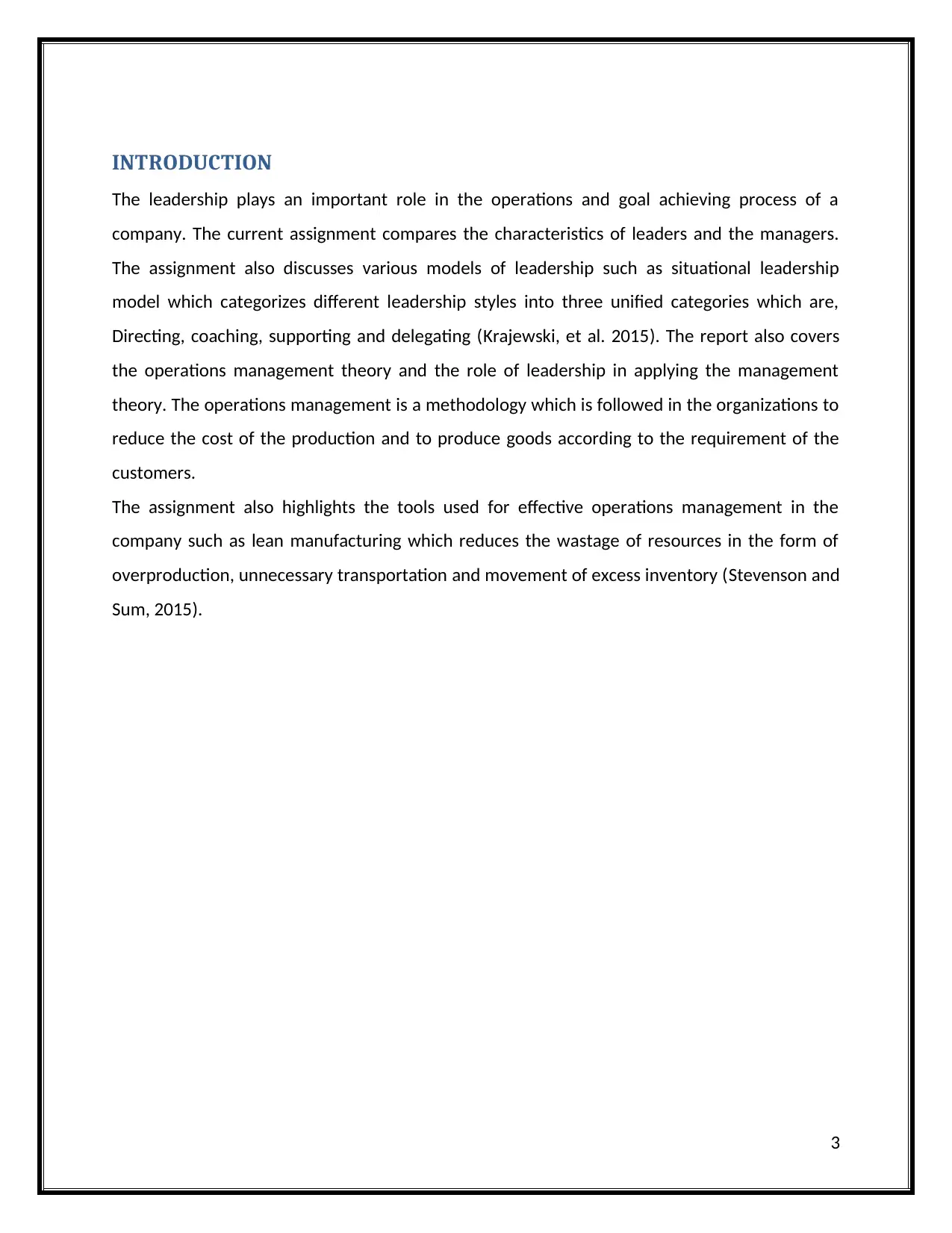
INTRODUCTION
The leadership plays an important role in the operations and goal achieving process of a
company. The current assignment compares the characteristics of leaders and the managers.
The assignment also discusses various models of leadership such as situational leadership
model which categorizes different leadership styles into three unified categories which are,
Directing, coaching, supporting and delegating (Krajewski, et al. 2015). The report also covers
the operations management theory and the role of leadership in applying the management
theory. The operations management is a methodology which is followed in the organizations to
reduce the cost of the production and to produce goods according to the requirement of the
customers.
The assignment also highlights the tools used for effective operations management in the
company such as lean manufacturing which reduces the wastage of resources in the form of
overproduction, unnecessary transportation and movement of excess inventory (Stevenson and
Sum, 2015).
3
The leadership plays an important role in the operations and goal achieving process of a
company. The current assignment compares the characteristics of leaders and the managers.
The assignment also discusses various models of leadership such as situational leadership
model which categorizes different leadership styles into three unified categories which are,
Directing, coaching, supporting and delegating (Krajewski, et al. 2015). The report also covers
the operations management theory and the role of leadership in applying the management
theory. The operations management is a methodology which is followed in the organizations to
reduce the cost of the production and to produce goods according to the requirement of the
customers.
The assignment also highlights the tools used for effective operations management in the
company such as lean manufacturing which reduces the wastage of resources in the form of
overproduction, unnecessary transportation and movement of excess inventory (Stevenson and
Sum, 2015).
3
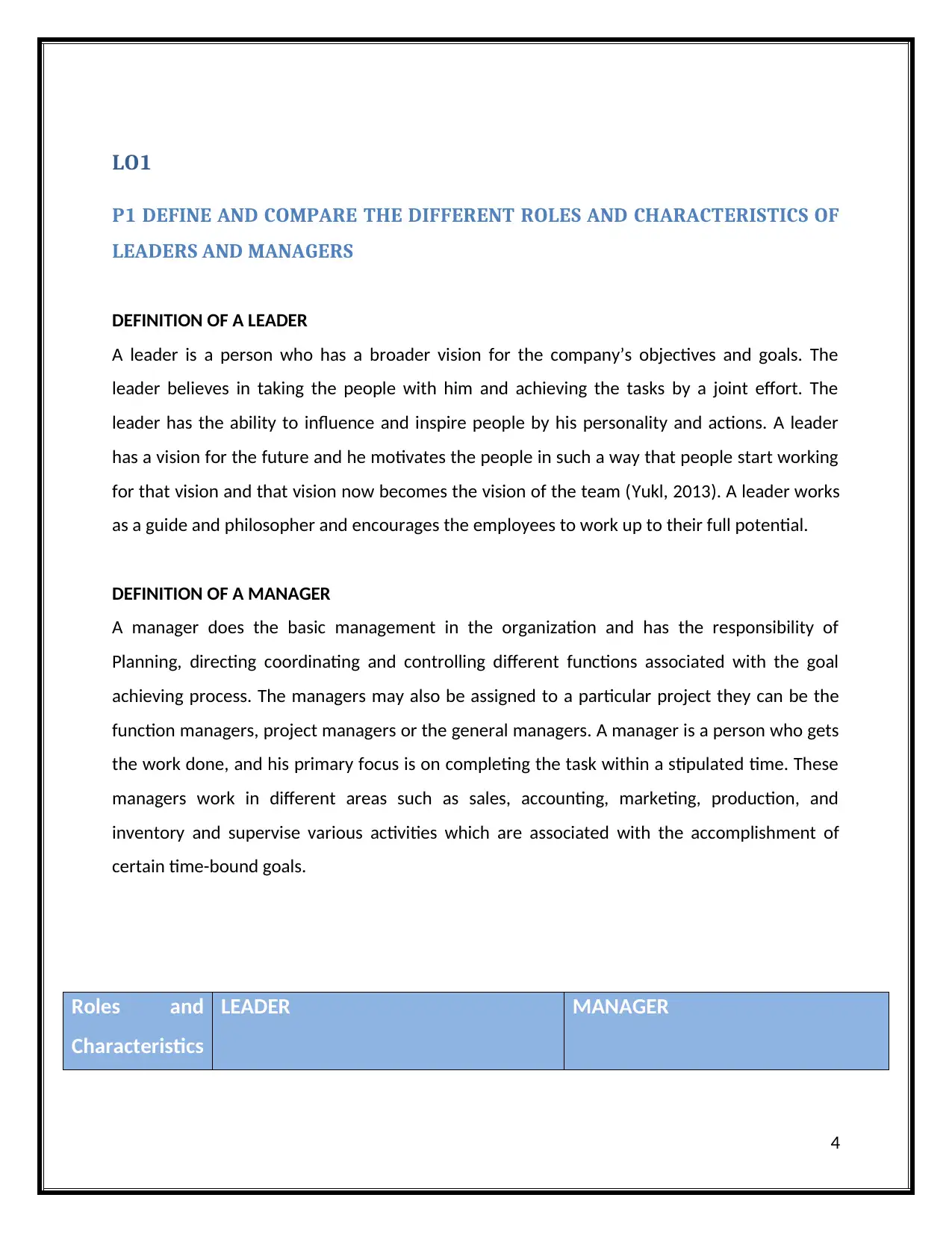
LO1
P1 DEFINE AND COMPARE THE DIFFERENT ROLES AND CHARACTERISTICS OF
LEADERS AND MANAGERS
DEFINITION OF A LEADER
A leader is a person who has a broader vision for the company’s objectives and goals. The
leader believes in taking the people with him and achieving the tasks by a joint effort. The
leader has the ability to influence and inspire people by his personality and actions. A leader
has a vision for the future and he motivates the people in such a way that people start working
for that vision and that vision now becomes the vision of the team (Yukl, 2013). A leader works
as a guide and philosopher and encourages the employees to work up to their full potential.
DEFINITION OF A MANAGER
A manager does the basic management in the organization and has the responsibility of
Planning, directing coordinating and controlling different functions associated with the goal
achieving process. The managers may also be assigned to a particular project they can be the
function managers, project managers or the general managers. A manager is a person who gets
the work done, and his primary focus is on completing the task within a stipulated time. These
managers work in different areas such as sales, accounting, marketing, production, and
inventory and supervise various activities which are associated with the accomplishment of
certain time-bound goals.
Roles and
Characteristics
LEADER MANAGER
4
P1 DEFINE AND COMPARE THE DIFFERENT ROLES AND CHARACTERISTICS OF
LEADERS AND MANAGERS
DEFINITION OF A LEADER
A leader is a person who has a broader vision for the company’s objectives and goals. The
leader believes in taking the people with him and achieving the tasks by a joint effort. The
leader has the ability to influence and inspire people by his personality and actions. A leader
has a vision for the future and he motivates the people in such a way that people start working
for that vision and that vision now becomes the vision of the team (Yukl, 2013). A leader works
as a guide and philosopher and encourages the employees to work up to their full potential.
DEFINITION OF A MANAGER
A manager does the basic management in the organization and has the responsibility of
Planning, directing coordinating and controlling different functions associated with the goal
achieving process. The managers may also be assigned to a particular project they can be the
function managers, project managers or the general managers. A manager is a person who gets
the work done, and his primary focus is on completing the task within a stipulated time. These
managers work in different areas such as sales, accounting, marketing, production, and
inventory and supervise various activities which are associated with the accomplishment of
certain time-bound goals.
Roles and
Characteristics
LEADER MANAGER
4
Secure Best Marks with AI Grader
Need help grading? Try our AI Grader for instant feedback on your assignments.
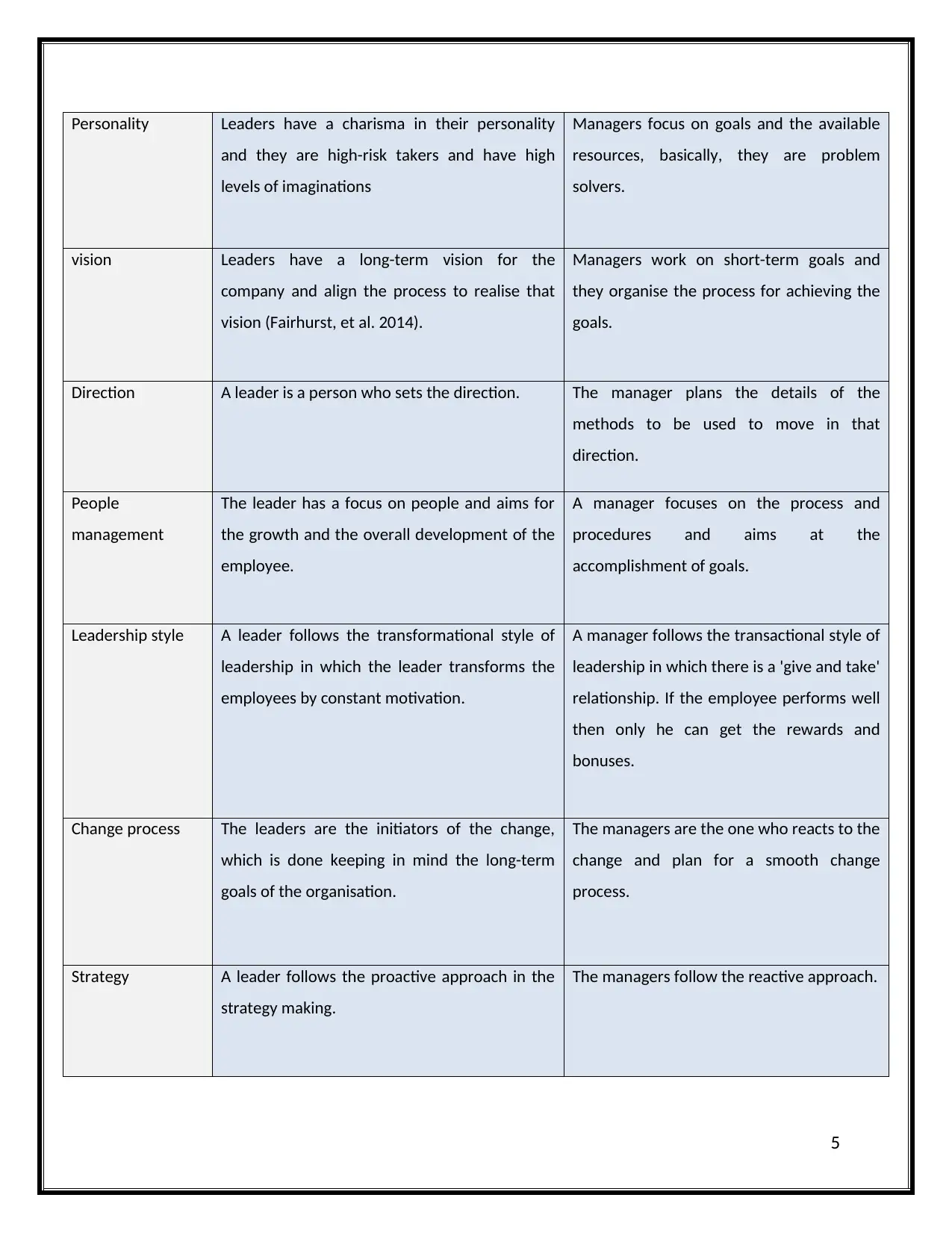
Personality Leaders have a charisma in their personality
and they are high-risk takers and have high
levels of imaginations
Managers focus on goals and the available
resources, basically, they are problem
solvers.
vision Leaders have a long-term vision for the
company and align the process to realise that
vision (Fairhurst, et al. 2014).
Managers work on short-term goals and
they organise the process for achieving the
goals.
Direction A leader is a person who sets the direction. The manager plans the details of the
methods to be used to move in that
direction.
People
management
The leader has a focus on people and aims for
the growth and the overall development of the
employee.
A manager focuses on the process and
procedures and aims at the
accomplishment of goals.
Leadership style A leader follows the transformational style of
leadership in which the leader transforms the
employees by constant motivation.
A manager follows the transactional style of
leadership in which there is a 'give and take'
relationship. If the employee performs well
then only he can get the rewards and
bonuses.
Change process The leaders are the initiators of the change,
which is done keeping in mind the long-term
goals of the organisation.
The managers are the one who reacts to the
change and plan for a smooth change
process.
Strategy A leader follows the proactive approach in the
strategy making.
The managers follow the reactive approach.
5
and they are high-risk takers and have high
levels of imaginations
Managers focus on goals and the available
resources, basically, they are problem
solvers.
vision Leaders have a long-term vision for the
company and align the process to realise that
vision (Fairhurst, et al. 2014).
Managers work on short-term goals and
they organise the process for achieving the
goals.
Direction A leader is a person who sets the direction. The manager plans the details of the
methods to be used to move in that
direction.
People
management
The leader has a focus on people and aims for
the growth and the overall development of the
employee.
A manager focuses on the process and
procedures and aims at the
accomplishment of goals.
Leadership style A leader follows the transformational style of
leadership in which the leader transforms the
employees by constant motivation.
A manager follows the transactional style of
leadership in which there is a 'give and take'
relationship. If the employee performs well
then only he can get the rewards and
bonuses.
Change process The leaders are the initiators of the change,
which is done keeping in mind the long-term
goals of the organisation.
The managers are the one who reacts to the
change and plan for a smooth change
process.
Strategy A leader follows the proactive approach in the
strategy making.
The managers follow the reactive approach.
5
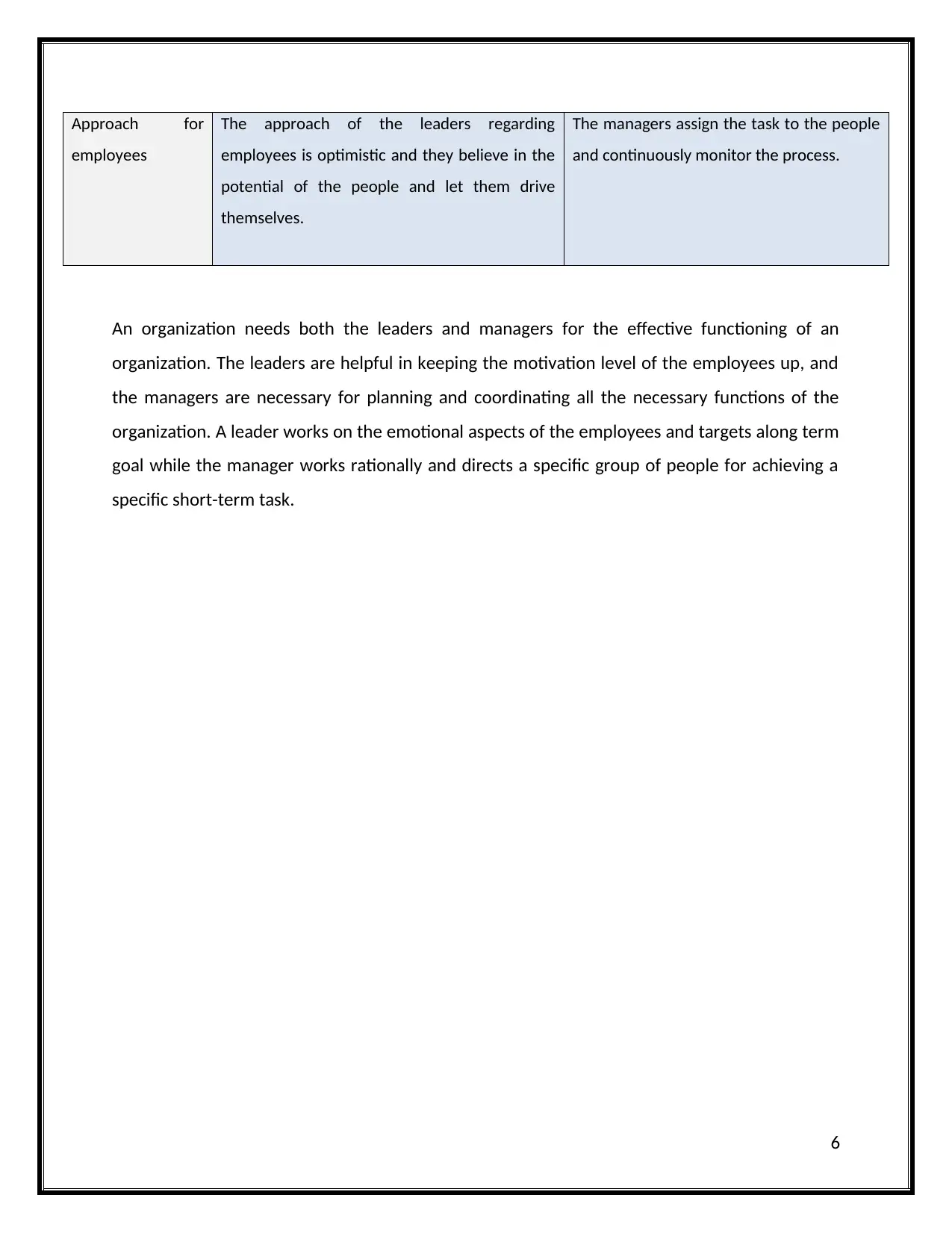
Approach for
employees
The approach of the leaders regarding
employees is optimistic and they believe in the
potential of the people and let them drive
themselves.
The managers assign the task to the people
and continuously monitor the process.
An organization needs both the leaders and managers for the effective functioning of an
organization. The leaders are helpful in keeping the motivation level of the employees up, and
the managers are necessary for planning and coordinating all the necessary functions of the
organization. A leader works on the emotional aspects of the employees and targets along term
goal while the manager works rationally and directs a specific group of people for achieving a
specific short-term task.
6
employees
The approach of the leaders regarding
employees is optimistic and they believe in the
potential of the people and let them drive
themselves.
The managers assign the task to the people
and continuously monitor the process.
An organization needs both the leaders and managers for the effective functioning of an
organization. The leaders are helpful in keeping the motivation level of the employees up, and
the managers are necessary for planning and coordinating all the necessary functions of the
organization. A leader works on the emotional aspects of the employees and targets along term
goal while the manager works rationally and directs a specific group of people for achieving a
specific short-term task.
6
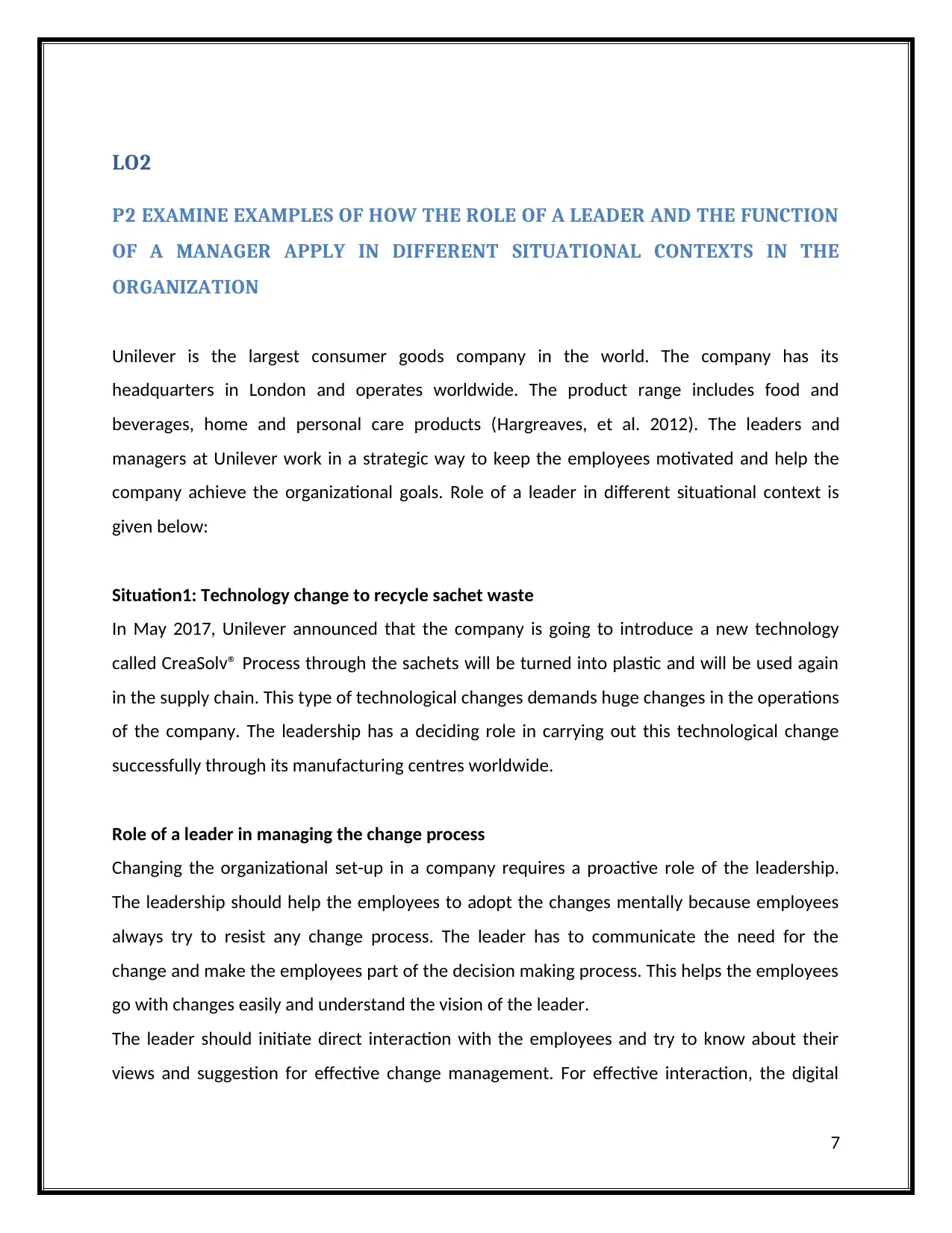
LO2
P2 EXAMINE EXAMPLES OF HOW THE ROLE OF A LEADER AND THE FUNCTION
OF A MANAGER APPLY IN DIFFERENT SITUATIONAL CONTEXTS IN THE
ORGANIZATION
Unilever is the largest consumer goods company in the world. The company has its
headquarters in London and operates worldwide. The product range includes food and
beverages, home and personal care products (Hargreaves, et al. 2012). The leaders and
managers at Unilever work in a strategic way to keep the employees motivated and help the
company achieve the organizational goals. Role of a leader in different situational context is
given below:
Situation1: Technology change to recycle sachet waste
In May 2017, Unilever announced that the company is going to introduce a new technology
called CreaSolv® Process through the sachets will be turned into plastic and will be used again
in the supply chain. This type of technological changes demands huge changes in the operations
of the company. The leadership has a deciding role in carrying out this technological change
successfully through its manufacturing centres worldwide.
Role of a leader in managing the change process
Changing the organizational set-up in a company requires a proactive role of the leadership.
The leadership should help the employees to adopt the changes mentally because employees
always try to resist any change process. The leader has to communicate the need for the
change and make the employees part of the decision making process. This helps the employees
go with changes easily and understand the vision of the leader.
The leader should initiate direct interaction with the employees and try to know about their
views and suggestion for effective change management. For effective interaction, the digital
7
P2 EXAMINE EXAMPLES OF HOW THE ROLE OF A LEADER AND THE FUNCTION
OF A MANAGER APPLY IN DIFFERENT SITUATIONAL CONTEXTS IN THE
ORGANIZATION
Unilever is the largest consumer goods company in the world. The company has its
headquarters in London and operates worldwide. The product range includes food and
beverages, home and personal care products (Hargreaves, et al. 2012). The leaders and
managers at Unilever work in a strategic way to keep the employees motivated and help the
company achieve the organizational goals. Role of a leader in different situational context is
given below:
Situation1: Technology change to recycle sachet waste
In May 2017, Unilever announced that the company is going to introduce a new technology
called CreaSolv® Process through the sachets will be turned into plastic and will be used again
in the supply chain. This type of technological changes demands huge changes in the operations
of the company. The leadership has a deciding role in carrying out this technological change
successfully through its manufacturing centres worldwide.
Role of a leader in managing the change process
Changing the organizational set-up in a company requires a proactive role of the leadership.
The leadership should help the employees to adopt the changes mentally because employees
always try to resist any change process. The leader has to communicate the need for the
change and make the employees part of the decision making process. This helps the employees
go with changes easily and understand the vision of the leader.
The leader should initiate direct interaction with the employees and try to know about their
views and suggestion for effective change management. For effective interaction, the digital
7
Paraphrase This Document
Need a fresh take? Get an instant paraphrase of this document with our AI Paraphraser
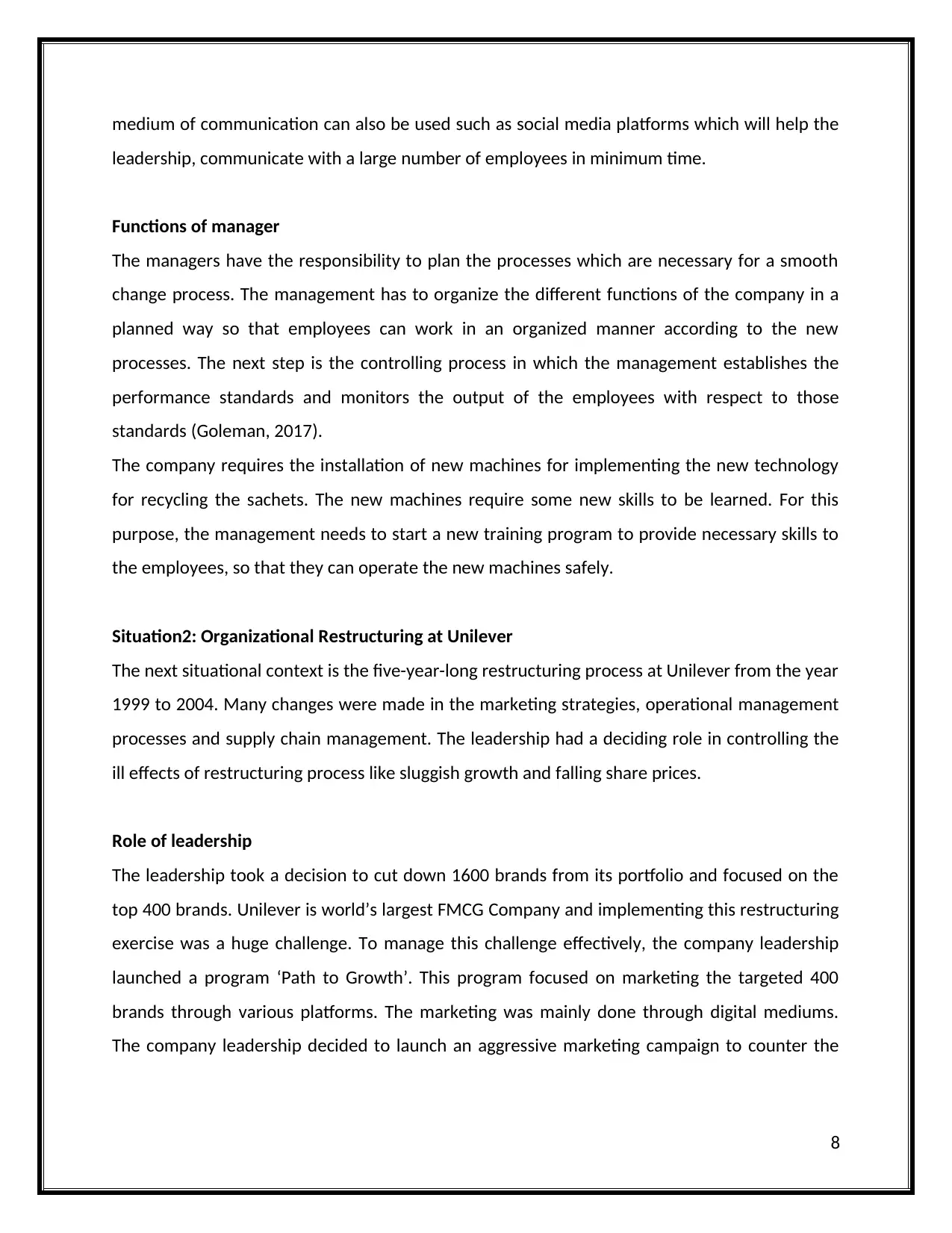
medium of communication can also be used such as social media platforms which will help the
leadership, communicate with a large number of employees in minimum time.
Functions of manager
The managers have the responsibility to plan the processes which are necessary for a smooth
change process. The management has to organize the different functions of the company in a
planned way so that employees can work in an organized manner according to the new
processes. The next step is the controlling process in which the management establishes the
performance standards and monitors the output of the employees with respect to those
standards (Goleman, 2017).
The company requires the installation of new machines for implementing the new technology
for recycling the sachets. The new machines require some new skills to be learned. For this
purpose, the management needs to start a new training program to provide necessary skills to
the employees, so that they can operate the new machines safely.
Situation2: Organizational Restructuring at Unilever
The next situational context is the five-year-long restructuring process at Unilever from the year
1999 to 2004. Many changes were made in the marketing strategies, operational management
processes and supply chain management. The leadership had a deciding role in controlling the
ill effects of restructuring process like sluggish growth and falling share prices.
Role of leadership
The leadership took a decision to cut down 1600 brands from its portfolio and focused on the
top 400 brands. Unilever is world’s largest FMCG Company and implementing this restructuring
exercise was a huge challenge. To manage this challenge effectively, the company leadership
launched a program ‘Path to Growth’. This program focused on marketing the targeted 400
brands through various platforms. The marketing was mainly done through digital mediums.
The company leadership decided to launch an aggressive marketing campaign to counter the
8
leadership, communicate with a large number of employees in minimum time.
Functions of manager
The managers have the responsibility to plan the processes which are necessary for a smooth
change process. The management has to organize the different functions of the company in a
planned way so that employees can work in an organized manner according to the new
processes. The next step is the controlling process in which the management establishes the
performance standards and monitors the output of the employees with respect to those
standards (Goleman, 2017).
The company requires the installation of new machines for implementing the new technology
for recycling the sachets. The new machines require some new skills to be learned. For this
purpose, the management needs to start a new training program to provide necessary skills to
the employees, so that they can operate the new machines safely.
Situation2: Organizational Restructuring at Unilever
The next situational context is the five-year-long restructuring process at Unilever from the year
1999 to 2004. Many changes were made in the marketing strategies, operational management
processes and supply chain management. The leadership had a deciding role in controlling the
ill effects of restructuring process like sluggish growth and falling share prices.
Role of leadership
The leadership took a decision to cut down 1600 brands from its portfolio and focused on the
top 400 brands. Unilever is world’s largest FMCG Company and implementing this restructuring
exercise was a huge challenge. To manage this challenge effectively, the company leadership
launched a program ‘Path to Growth’. This program focused on marketing the targeted 400
brands through various platforms. The marketing was mainly done through digital mediums.
The company leadership decided to launch an aggressive marketing campaign to counter the
8
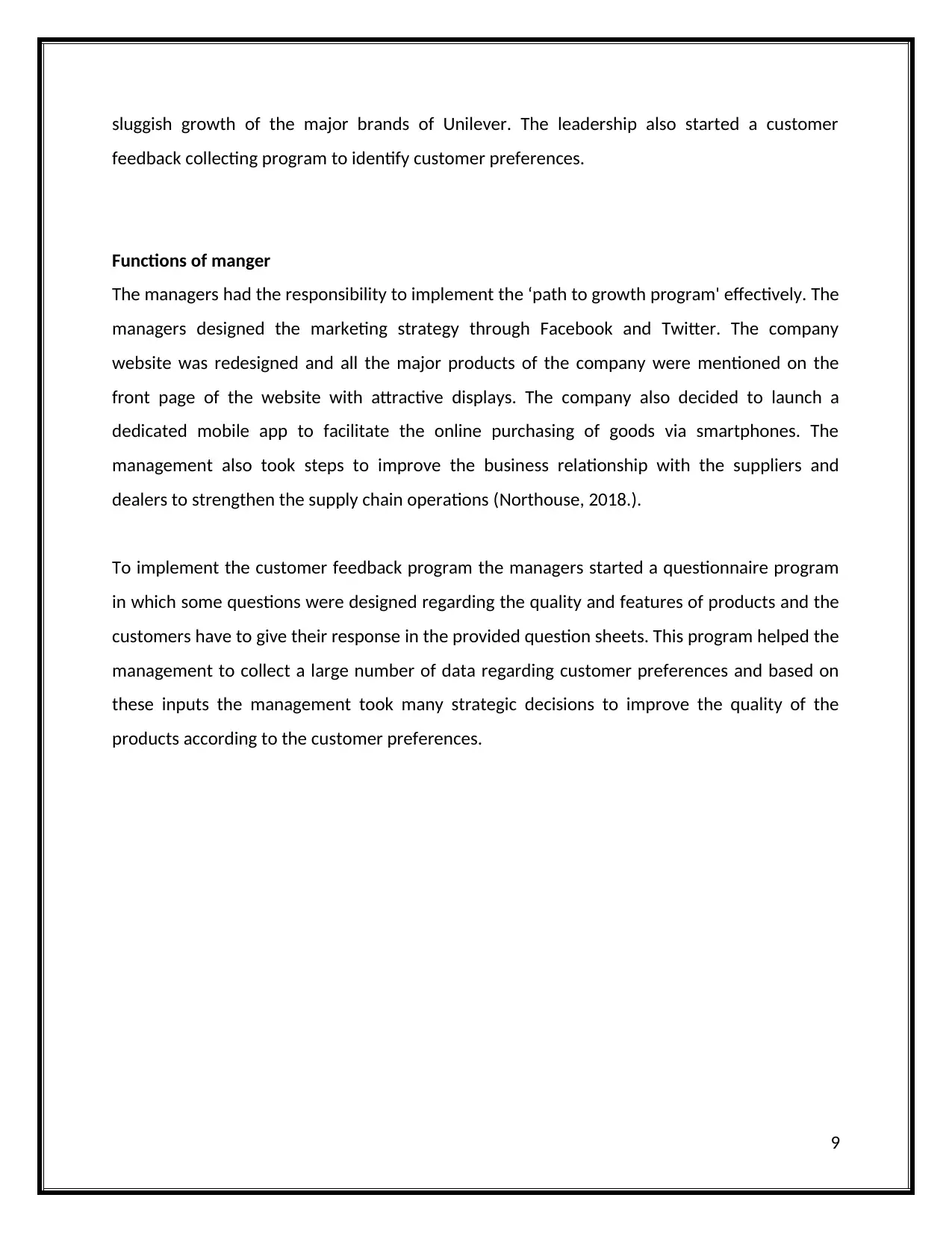
sluggish growth of the major brands of Unilever. The leadership also started a customer
feedback collecting program to identify customer preferences.
Functions of manger
The managers had the responsibility to implement the ‘path to growth program' effectively. The
managers designed the marketing strategy through Facebook and Twitter. The company
website was redesigned and all the major products of the company were mentioned on the
front page of the website with attractive displays. The company also decided to launch a
dedicated mobile app to facilitate the online purchasing of goods via smartphones. The
management also took steps to improve the business relationship with the suppliers and
dealers to strengthen the supply chain operations (Northouse, 2018.).
To implement the customer feedback program the managers started a questionnaire program
in which some questions were designed regarding the quality and features of products and the
customers have to give their response in the provided question sheets. This program helped the
management to collect a large number of data regarding customer preferences and based on
these inputs the management took many strategic decisions to improve the quality of the
products according to the customer preferences.
9
feedback collecting program to identify customer preferences.
Functions of manger
The managers had the responsibility to implement the ‘path to growth program' effectively. The
managers designed the marketing strategy through Facebook and Twitter. The company
website was redesigned and all the major products of the company were mentioned on the
front page of the website with attractive displays. The company also decided to launch a
dedicated mobile app to facilitate the online purchasing of goods via smartphones. The
management also took steps to improve the business relationship with the suppliers and
dealers to strengthen the supply chain operations (Northouse, 2018.).
To implement the customer feedback program the managers started a questionnaire program
in which some questions were designed regarding the quality and features of products and the
customers have to give their response in the provided question sheets. This program helped the
management to collect a large number of data regarding customer preferences and based on
these inputs the management took many strategic decisions to improve the quality of the
products according to the customer preferences.
9
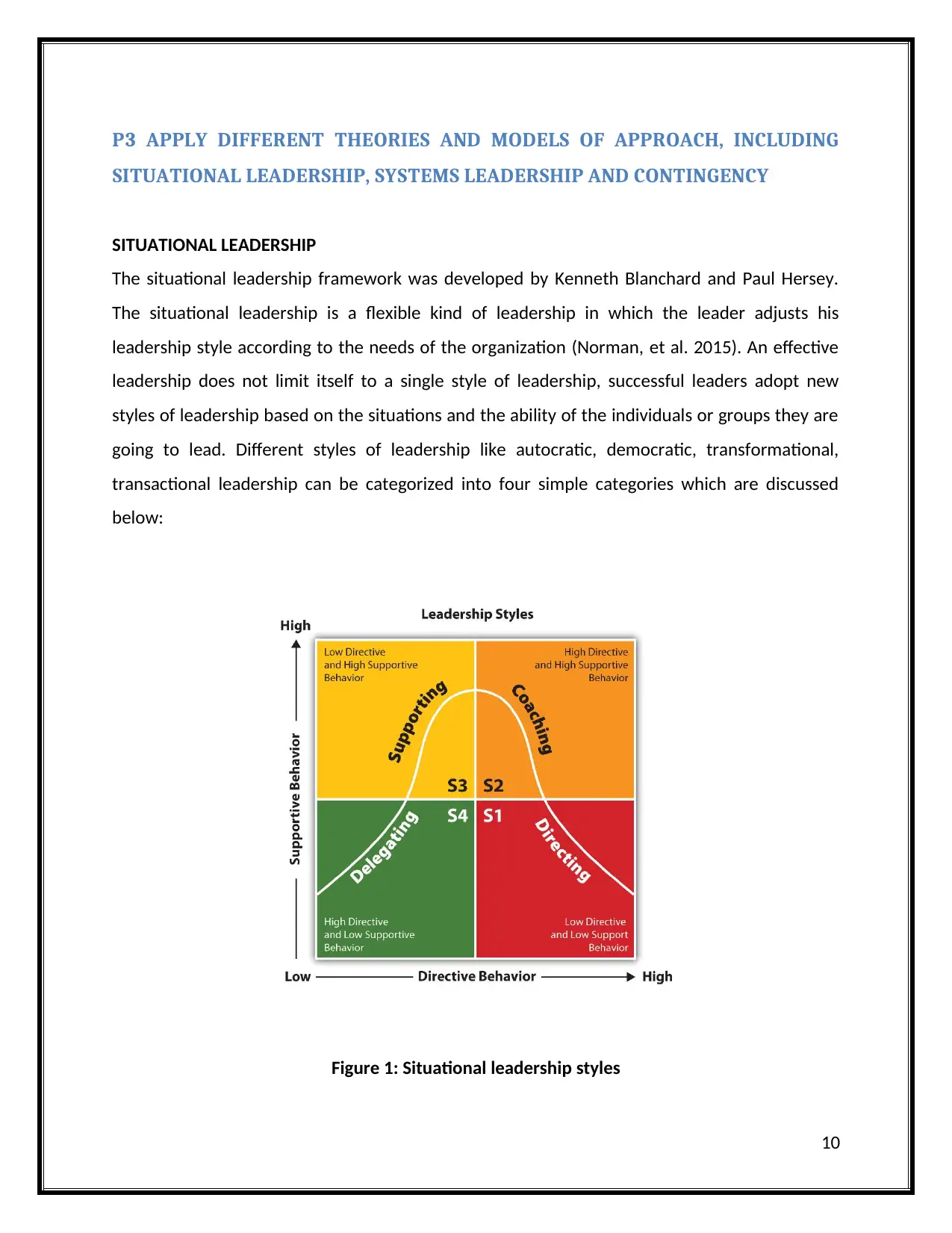
P3 APPLY DIFFERENT THEORIES AND MODELS OF APPROACH, INCLUDING
SITUATIONAL LEADERSHIP, SYSTEMS LEADERSHIP AND CONTINGENCY
SITUATIONAL LEADERSHIP
The situational leadership framework was developed by Kenneth Blanchard and Paul Hersey.
The situational leadership is a flexible kind of leadership in which the leader adjusts his
leadership style according to the needs of the organization (Norman, et al. 2015). An effective
leadership does not limit itself to a single style of leadership, successful leaders adopt new
styles of leadership based on the situations and the ability of the individuals or groups they are
going to lead. Different styles of leadership like autocratic, democratic, transformational,
transactional leadership can be categorized into four simple categories which are discussed
below:
Figure 1: Situational leadership styles
10
SITUATIONAL LEADERSHIP, SYSTEMS LEADERSHIP AND CONTINGENCY
SITUATIONAL LEADERSHIP
The situational leadership framework was developed by Kenneth Blanchard and Paul Hersey.
The situational leadership is a flexible kind of leadership in which the leader adjusts his
leadership style according to the needs of the organization (Norman, et al. 2015). An effective
leadership does not limit itself to a single style of leadership, successful leaders adopt new
styles of leadership based on the situations and the ability of the individuals or groups they are
going to lead. Different styles of leadership like autocratic, democratic, transformational,
transactional leadership can be categorized into four simple categories which are discussed
below:
Figure 1: Situational leadership styles
10
Secure Best Marks with AI Grader
Need help grading? Try our AI Grader for instant feedback on your assignments.
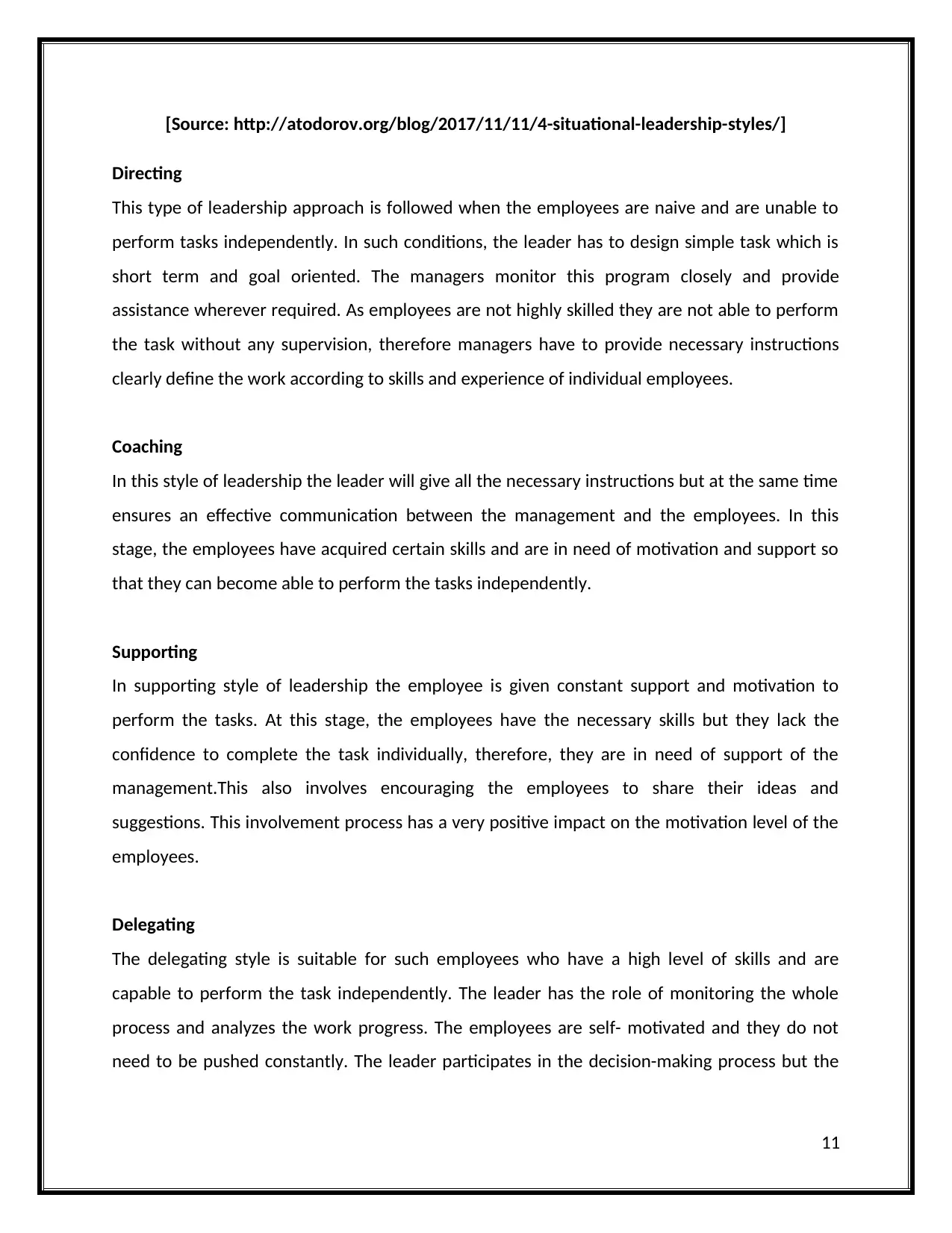
[Source: http://atodorov.org/blog/2017/11/11/4-situational-leadership-styles/]
Directing
This type of leadership approach is followed when the employees are naive and are unable to
perform tasks independently. In such conditions, the leader has to design simple task which is
short term and goal oriented. The managers monitor this program closely and provide
assistance wherever required. As employees are not highly skilled they are not able to perform
the task without any supervision, therefore managers have to provide necessary instructions
clearly define the work according to skills and experience of individual employees.
Coaching
In this style of leadership the leader will give all the necessary instructions but at the same time
ensures an effective communication between the management and the employees. In this
stage, the employees have acquired certain skills and are in need of motivation and support so
that they can become able to perform the tasks independently.
Supporting
In supporting style of leadership the employee is given constant support and motivation to
perform the tasks. At this stage, the employees have the necessary skills but they lack the
confidence to complete the task individually, therefore, they are in need of support of the
management.This also involves encouraging the employees to share their ideas and
suggestions. This involvement process has a very positive impact on the motivation level of the
employees.
Delegating
The delegating style is suitable for such employees who have a high level of skills and are
capable to perform the task independently. The leader has the role of monitoring the whole
process and analyzes the work progress. The employees are self- motivated and they do not
need to be pushed constantly. The leader participates in the decision-making process but the
11
Directing
This type of leadership approach is followed when the employees are naive and are unable to
perform tasks independently. In such conditions, the leader has to design simple task which is
short term and goal oriented. The managers monitor this program closely and provide
assistance wherever required. As employees are not highly skilled they are not able to perform
the task without any supervision, therefore managers have to provide necessary instructions
clearly define the work according to skills and experience of individual employees.
Coaching
In this style of leadership the leader will give all the necessary instructions but at the same time
ensures an effective communication between the management and the employees. In this
stage, the employees have acquired certain skills and are in need of motivation and support so
that they can become able to perform the tasks independently.
Supporting
In supporting style of leadership the employee is given constant support and motivation to
perform the tasks. At this stage, the employees have the necessary skills but they lack the
confidence to complete the task individually, therefore, they are in need of support of the
management.This also involves encouraging the employees to share their ideas and
suggestions. This involvement process has a very positive impact on the motivation level of the
employees.
Delegating
The delegating style is suitable for such employees who have a high level of skills and are
capable to perform the task independently. The leader has the role of monitoring the whole
process and analyzes the work progress. The employees are self- motivated and they do not
need to be pushed constantly. The leader participates in the decision-making process but the
11
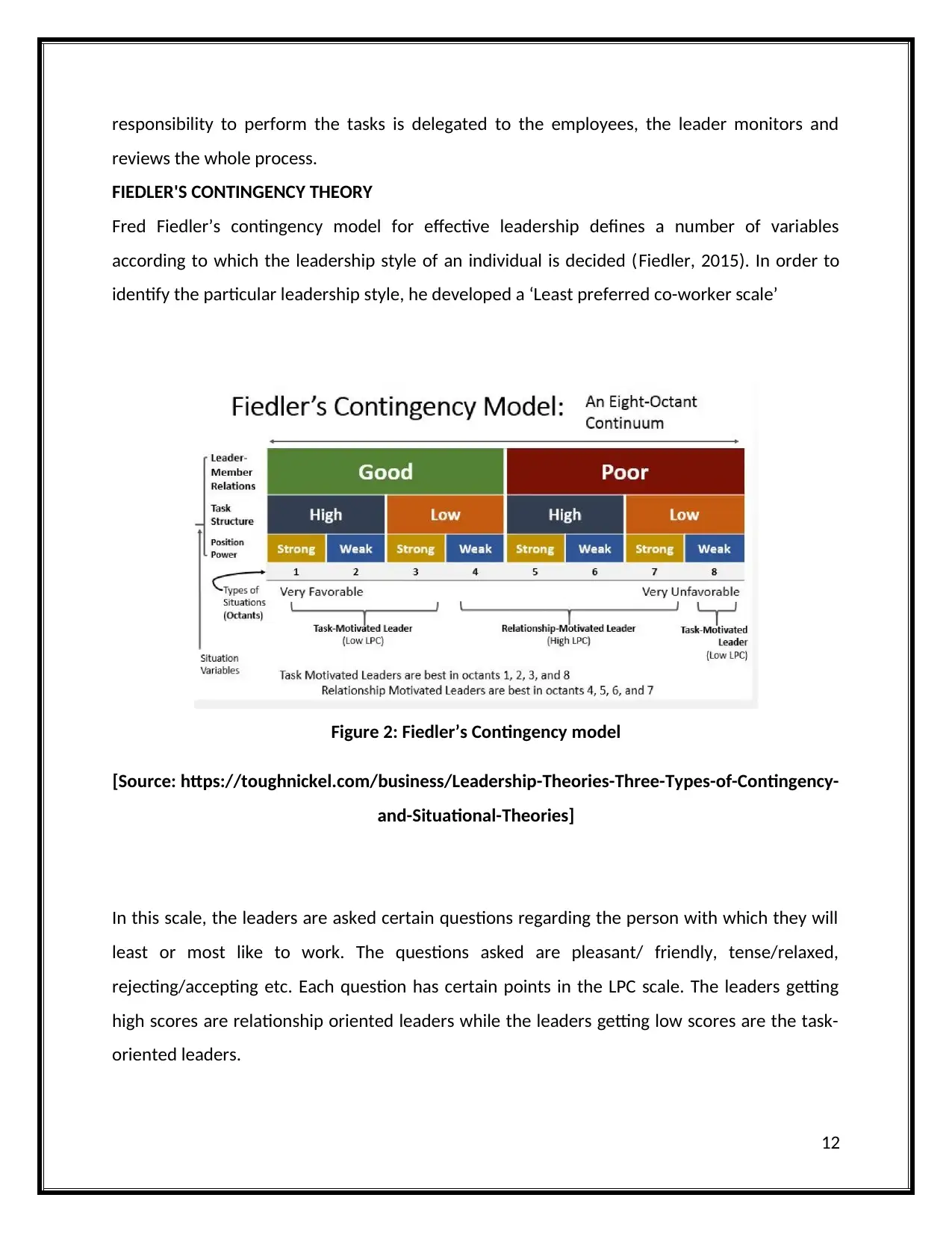
responsibility to perform the tasks is delegated to the employees, the leader monitors and
reviews the whole process.
FIEDLER'S CONTINGENCY THEORY
Fred Fiedler’s contingency model for effective leadership defines a number of variables
according to which the leadership style of an individual is decided (Fiedler, 2015). In order to
identify the particular leadership style, he developed a ‘Least preferred co-worker scale’
Figure 2: Fiedler’s Contingency model
[Source: https://toughnickel.com/business/Leadership-Theories-Three-Types-of-Contingency-
and-Situational-Theories]
In this scale, the leaders are asked certain questions regarding the person with which they will
least or most like to work. The questions asked are pleasant/ friendly, tense/relaxed,
rejecting/accepting etc. Each question has certain points in the LPC scale. The leaders getting
high scores are relationship oriented leaders while the leaders getting low scores are the task-
oriented leaders.
12
reviews the whole process.
FIEDLER'S CONTINGENCY THEORY
Fred Fiedler’s contingency model for effective leadership defines a number of variables
according to which the leadership style of an individual is decided (Fiedler, 2015). In order to
identify the particular leadership style, he developed a ‘Least preferred co-worker scale’
Figure 2: Fiedler’s Contingency model
[Source: https://toughnickel.com/business/Leadership-Theories-Three-Types-of-Contingency-
and-Situational-Theories]
In this scale, the leaders are asked certain questions regarding the person with which they will
least or most like to work. The questions asked are pleasant/ friendly, tense/relaxed,
rejecting/accepting etc. Each question has certain points in the LPC scale. The leaders getting
high scores are relationship oriented leaders while the leaders getting low scores are the task-
oriented leaders.
12
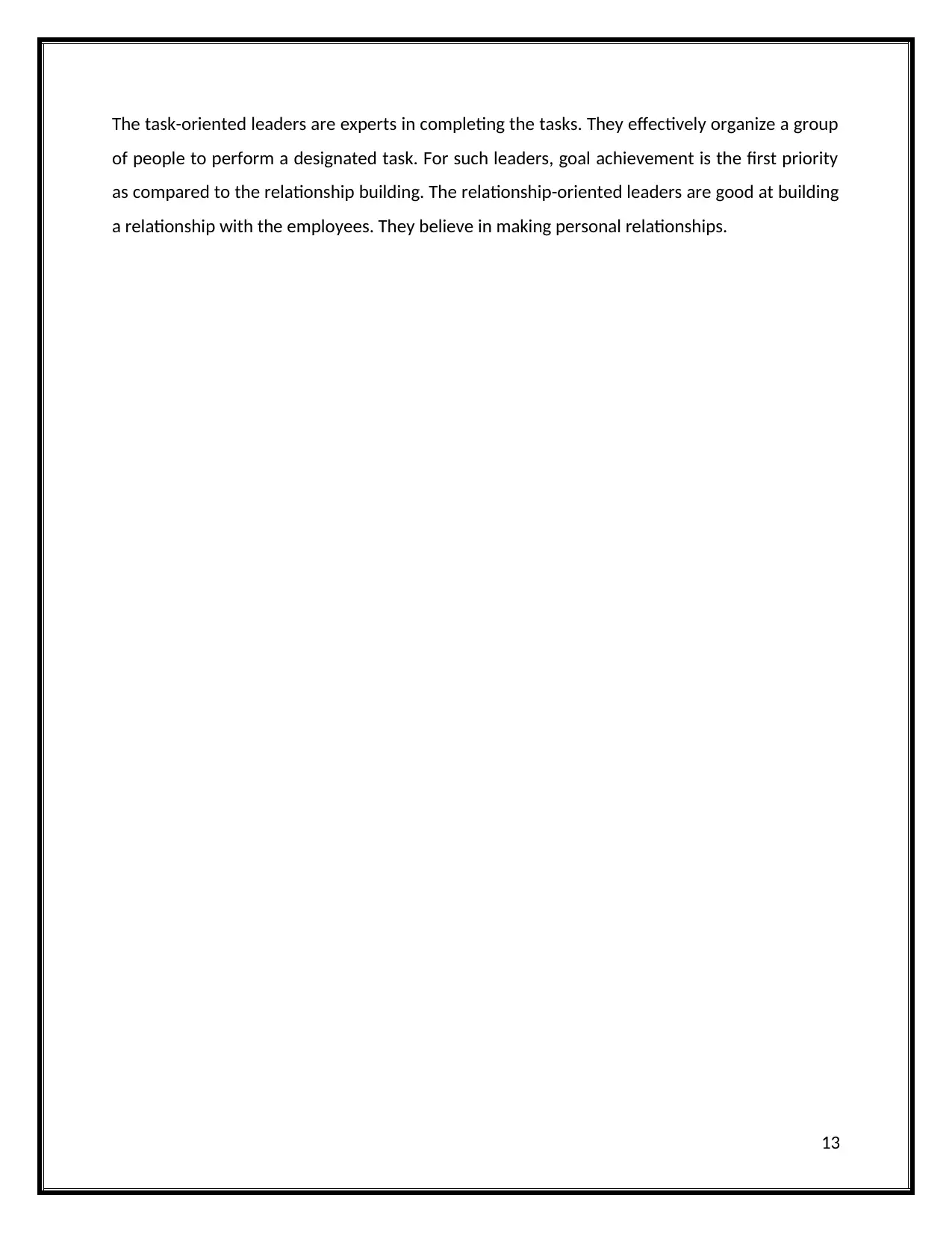
The task-oriented leaders are experts in completing the tasks. They effectively organize a group
of people to perform a designated task. For such leaders, goal achievement is the first priority
as compared to the relationship building. The relationship-oriented leaders are good at building
a relationship with the employees. They believe in making personal relationships.
13
of people to perform a designated task. For such leaders, goal achievement is the first priority
as compared to the relationship building. The relationship-oriented leaders are good at building
a relationship with the employees. They believe in making personal relationships.
13
Paraphrase This Document
Need a fresh take? Get an instant paraphrase of this document with our AI Paraphraser
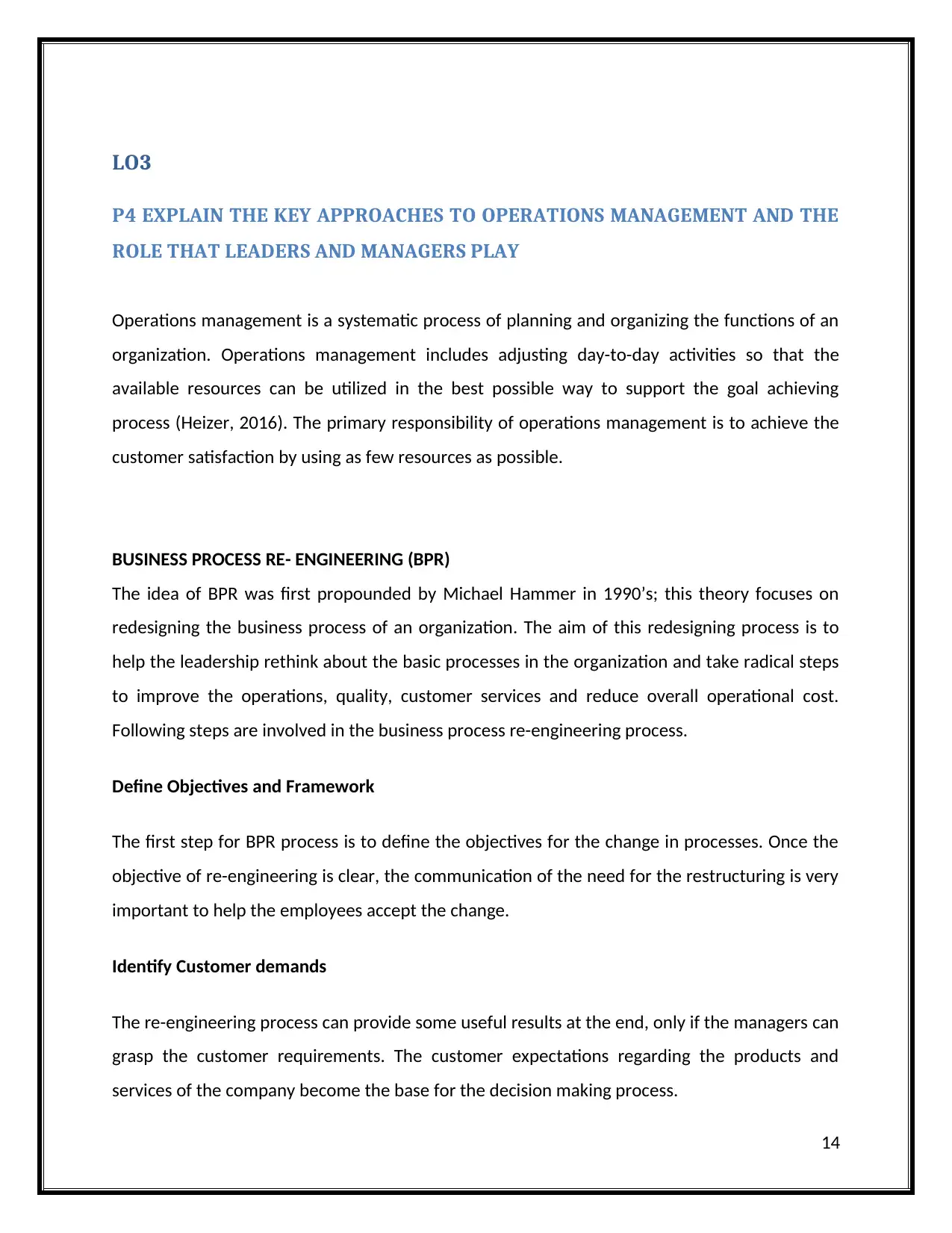
LO3
P4 EXPLAIN THE KEY APPROACHES TO OPERATIONS MANAGEMENT AND THE
ROLE THAT LEADERS AND MANAGERS PLAY
Operations management is a systematic process of planning and organizing the functions of an
organization. Operations management includes adjusting day-to-day activities so that the
available resources can be utilized in the best possible way to support the goal achieving
process (Heizer, 2016). The primary responsibility of operations management is to achieve the
customer satisfaction by using as few resources as possible.
BUSINESS PROCESS RE- ENGINEERING (BPR)
The idea of BPR was first propounded by Michael Hammer in 1990’s; this theory focuses on
redesigning the business process of an organization. The aim of this redesigning process is to
help the leadership rethink about the basic processes in the organization and take radical steps
to improve the operations, quality, customer services and reduce overall operational cost.
Following steps are involved in the business process re-engineering process.
Define Objectives and Framework
The first step for BPR process is to define the objectives for the change in processes. Once the
objective of re-engineering is clear, the communication of the need for the restructuring is very
important to help the employees accept the change.
Identify Customer demands
The re-engineering process can provide some useful results at the end, only if the managers can
grasp the customer requirements. The customer expectations regarding the products and
services of the company become the base for the decision making process.
14
P4 EXPLAIN THE KEY APPROACHES TO OPERATIONS MANAGEMENT AND THE
ROLE THAT LEADERS AND MANAGERS PLAY
Operations management is a systematic process of planning and organizing the functions of an
organization. Operations management includes adjusting day-to-day activities so that the
available resources can be utilized in the best possible way to support the goal achieving
process (Heizer, 2016). The primary responsibility of operations management is to achieve the
customer satisfaction by using as few resources as possible.
BUSINESS PROCESS RE- ENGINEERING (BPR)
The idea of BPR was first propounded by Michael Hammer in 1990’s; this theory focuses on
redesigning the business process of an organization. The aim of this redesigning process is to
help the leadership rethink about the basic processes in the organization and take radical steps
to improve the operations, quality, customer services and reduce overall operational cost.
Following steps are involved in the business process re-engineering process.
Define Objectives and Framework
The first step for BPR process is to define the objectives for the change in processes. Once the
objective of re-engineering is clear, the communication of the need for the restructuring is very
important to help the employees accept the change.
Identify Customer demands
The re-engineering process can provide some useful results at the end, only if the managers can
grasp the customer requirements. The customer expectations regarding the products and
services of the company become the base for the decision making process.
14
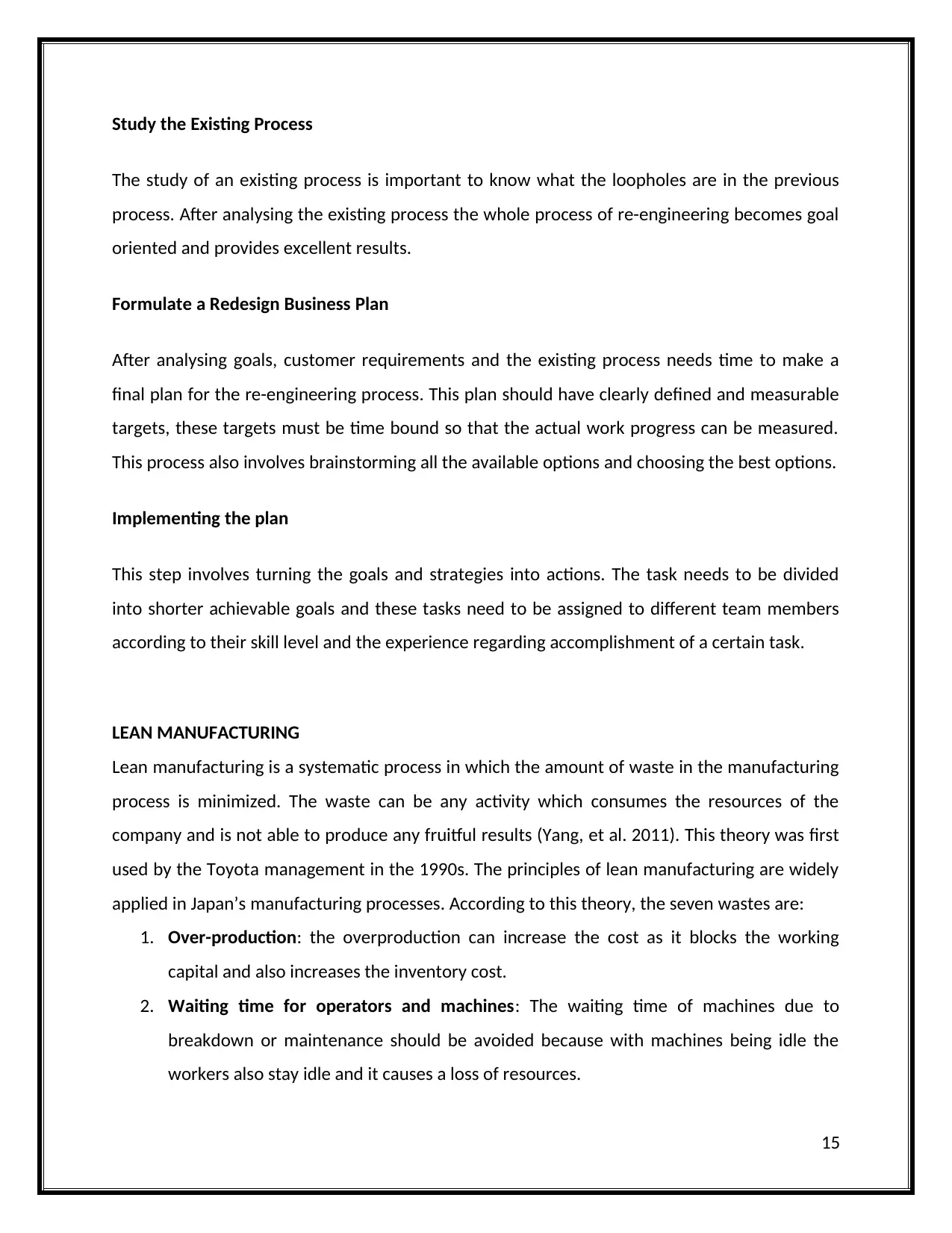
Study the Existing Process
The study of an existing process is important to know what the loopholes are in the previous
process. After analysing the existing process the whole process of re-engineering becomes goal
oriented and provides excellent results.
Formulate a Redesign Business Plan
After analysing goals, customer requirements and the existing process needs time to make a
final plan for the re-engineering process. This plan should have clearly defined and measurable
targets, these targets must be time bound so that the actual work progress can be measured.
This process also involves brainstorming all the available options and choosing the best options.
Implementing the plan
This step involves turning the goals and strategies into actions. The task needs to be divided
into shorter achievable goals and these tasks need to be assigned to different team members
according to their skill level and the experience regarding accomplishment of a certain task.
LEAN MANUFACTURING
Lean manufacturing is a systematic process in which the amount of waste in the manufacturing
process is minimized. The waste can be any activity which consumes the resources of the
company and is not able to produce any fruitful results (Yang, et al. 2011). This theory was first
used by the Toyota management in the 1990s. The principles of lean manufacturing are widely
applied in Japan’s manufacturing processes. According to this theory, the seven wastes are:
1. Over-production: the overproduction can increase the cost as it blocks the working
capital and also increases the inventory cost.
2. Waiting time for operators and machines: The waiting time of machines due to
breakdown or maintenance should be avoided because with machines being idle the
workers also stay idle and it causes a loss of resources.
15
The study of an existing process is important to know what the loopholes are in the previous
process. After analysing the existing process the whole process of re-engineering becomes goal
oriented and provides excellent results.
Formulate a Redesign Business Plan
After analysing goals, customer requirements and the existing process needs time to make a
final plan for the re-engineering process. This plan should have clearly defined and measurable
targets, these targets must be time bound so that the actual work progress can be measured.
This process also involves brainstorming all the available options and choosing the best options.
Implementing the plan
This step involves turning the goals and strategies into actions. The task needs to be divided
into shorter achievable goals and these tasks need to be assigned to different team members
according to their skill level and the experience regarding accomplishment of a certain task.
LEAN MANUFACTURING
Lean manufacturing is a systematic process in which the amount of waste in the manufacturing
process is minimized. The waste can be any activity which consumes the resources of the
company and is not able to produce any fruitful results (Yang, et al. 2011). This theory was first
used by the Toyota management in the 1990s. The principles of lean manufacturing are widely
applied in Japan’s manufacturing processes. According to this theory, the seven wastes are:
1. Over-production: the overproduction can increase the cost as it blocks the working
capital and also increases the inventory cost.
2. Waiting time for operators and machines: The waiting time of machines due to
breakdown or maintenance should be avoided because with machines being idle the
workers also stay idle and it causes a loss of resources.
15
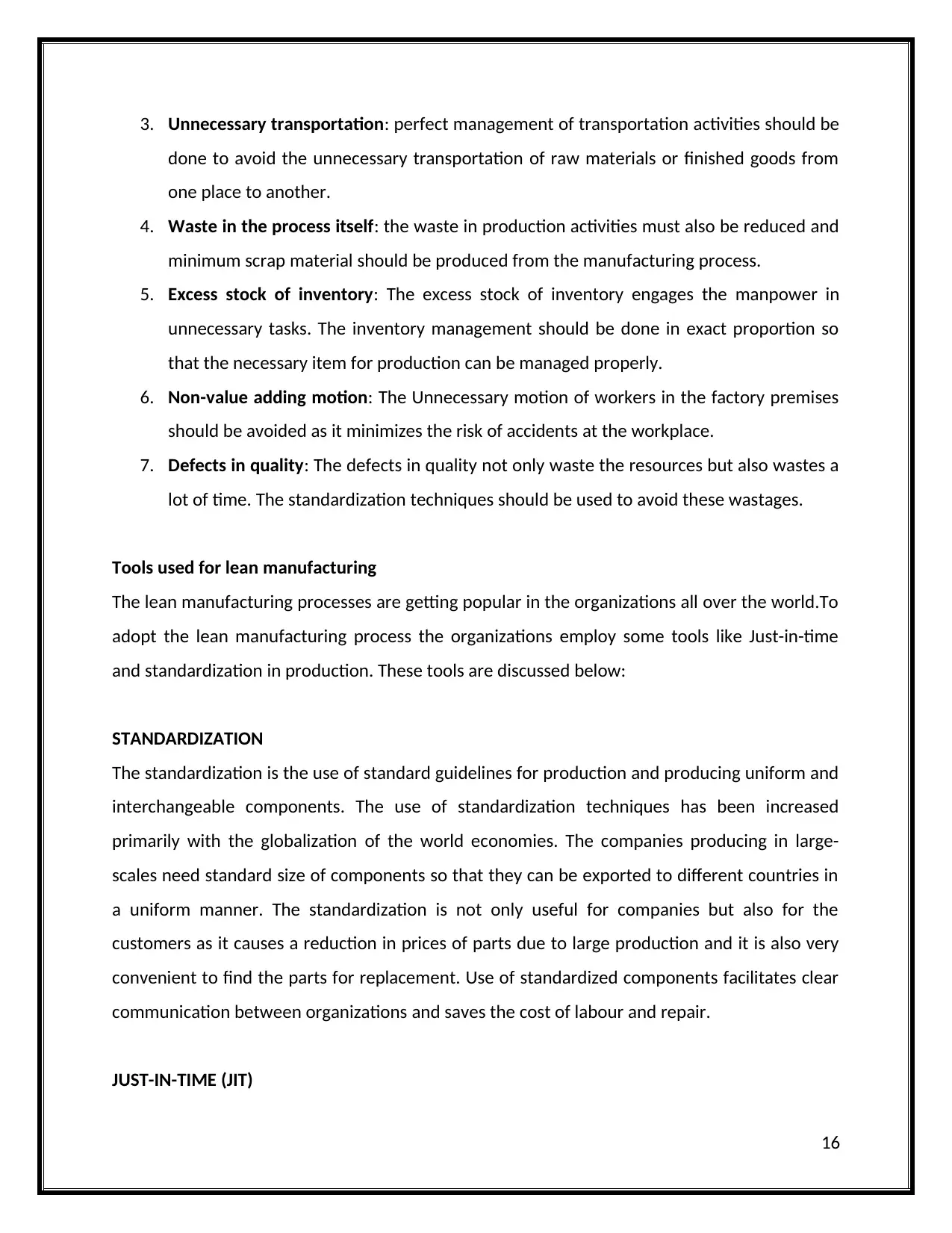
3. Unnecessary transportation: perfect management of transportation activities should be
done to avoid the unnecessary transportation of raw materials or finished goods from
one place to another.
4. Waste in the process itself: the waste in production activities must also be reduced and
minimum scrap material should be produced from the manufacturing process.
5. Excess stock of inventory: The excess stock of inventory engages the manpower in
unnecessary tasks. The inventory management should be done in exact proportion so
that the necessary item for production can be managed properly.
6. Non-value adding motion: The Unnecessary motion of workers in the factory premises
should be avoided as it minimizes the risk of accidents at the workplace.
7. Defects in quality: The defects in quality not only waste the resources but also wastes a
lot of time. The standardization techniques should be used to avoid these wastages.
Tools used for lean manufacturing
The lean manufacturing processes are getting popular in the organizations all over the world.To
adopt the lean manufacturing process the organizations employ some tools like Just-in-time
and standardization in production. These tools are discussed below:
STANDARDIZATION
The standardization is the use of standard guidelines for production and producing uniform and
interchangeable components. The use of standardization techniques has been increased
primarily with the globalization of the world economies. The companies producing in large-
scales need standard size of components so that they can be exported to different countries in
a uniform manner. The standardization is not only useful for companies but also for the
customers as it causes a reduction in prices of parts due to large production and it is also very
convenient to find the parts for replacement. Use of standardized components facilitates clear
communication between organizations and saves the cost of labour and repair.
JUST-IN-TIME (JIT)
16
done to avoid the unnecessary transportation of raw materials or finished goods from
one place to another.
4. Waste in the process itself: the waste in production activities must also be reduced and
minimum scrap material should be produced from the manufacturing process.
5. Excess stock of inventory: The excess stock of inventory engages the manpower in
unnecessary tasks. The inventory management should be done in exact proportion so
that the necessary item for production can be managed properly.
6. Non-value adding motion: The Unnecessary motion of workers in the factory premises
should be avoided as it minimizes the risk of accidents at the workplace.
7. Defects in quality: The defects in quality not only waste the resources but also wastes a
lot of time. The standardization techniques should be used to avoid these wastages.
Tools used for lean manufacturing
The lean manufacturing processes are getting popular in the organizations all over the world.To
adopt the lean manufacturing process the organizations employ some tools like Just-in-time
and standardization in production. These tools are discussed below:
STANDARDIZATION
The standardization is the use of standard guidelines for production and producing uniform and
interchangeable components. The use of standardization techniques has been increased
primarily with the globalization of the world economies. The companies producing in large-
scales need standard size of components so that they can be exported to different countries in
a uniform manner. The standardization is not only useful for companies but also for the
customers as it causes a reduction in prices of parts due to large production and it is also very
convenient to find the parts for replacement. Use of standardized components facilitates clear
communication between organizations and saves the cost of labour and repair.
JUST-IN-TIME (JIT)
16
Secure Best Marks with AI Grader
Need help grading? Try our AI Grader for instant feedback on your assignments.
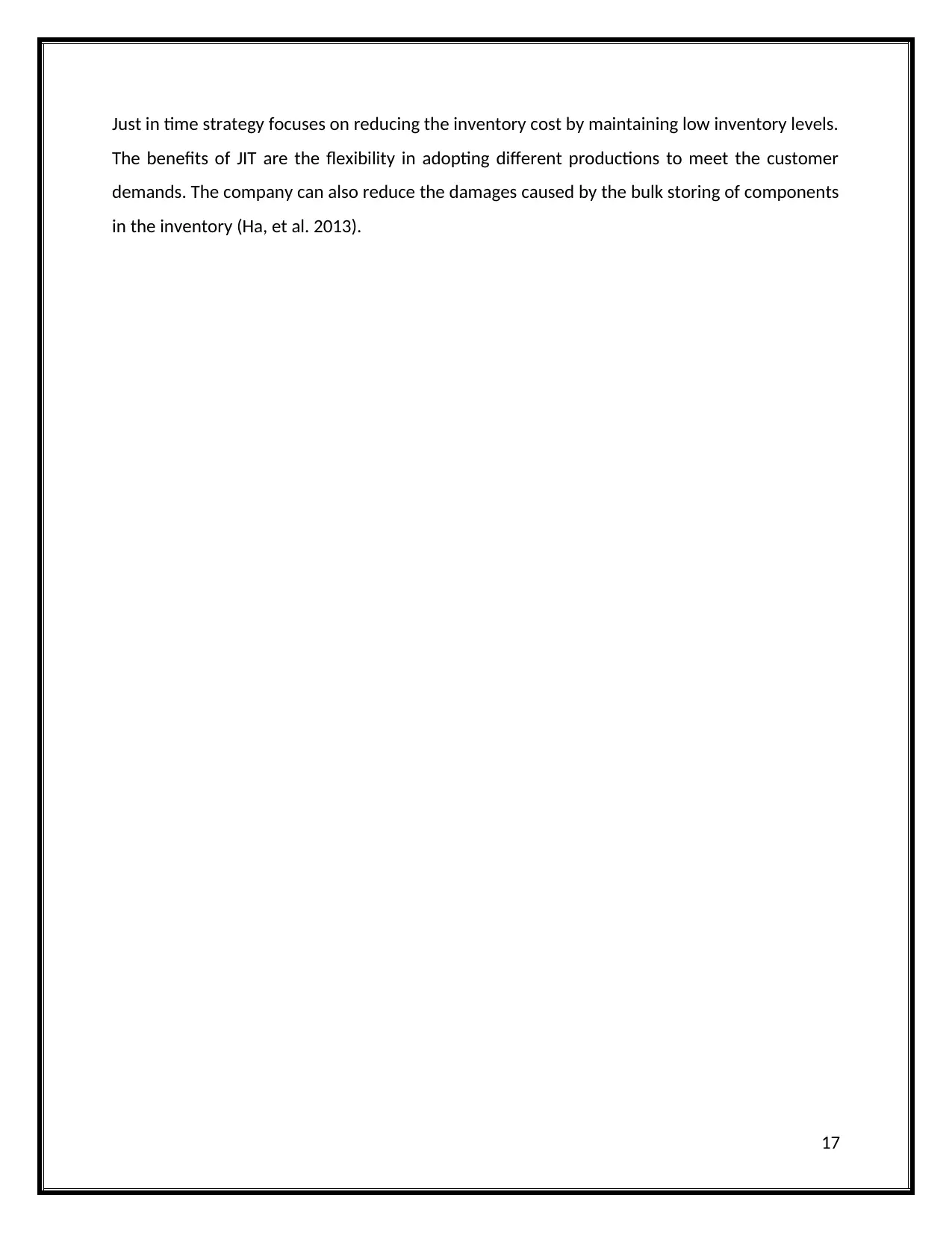
Just in time strategy focuses on reducing the inventory cost by maintaining low inventory levels.
The benefits of JIT are the flexibility in adopting different productions to meet the customer
demands. The company can also reduce the damages caused by the bulk storing of components
in the inventory (Ha, et al. 2013).
17
The benefits of JIT are the flexibility in adopting different productions to meet the customer
demands. The company can also reduce the damages caused by the bulk storing of components
in the inventory (Ha, et al. 2013).
17
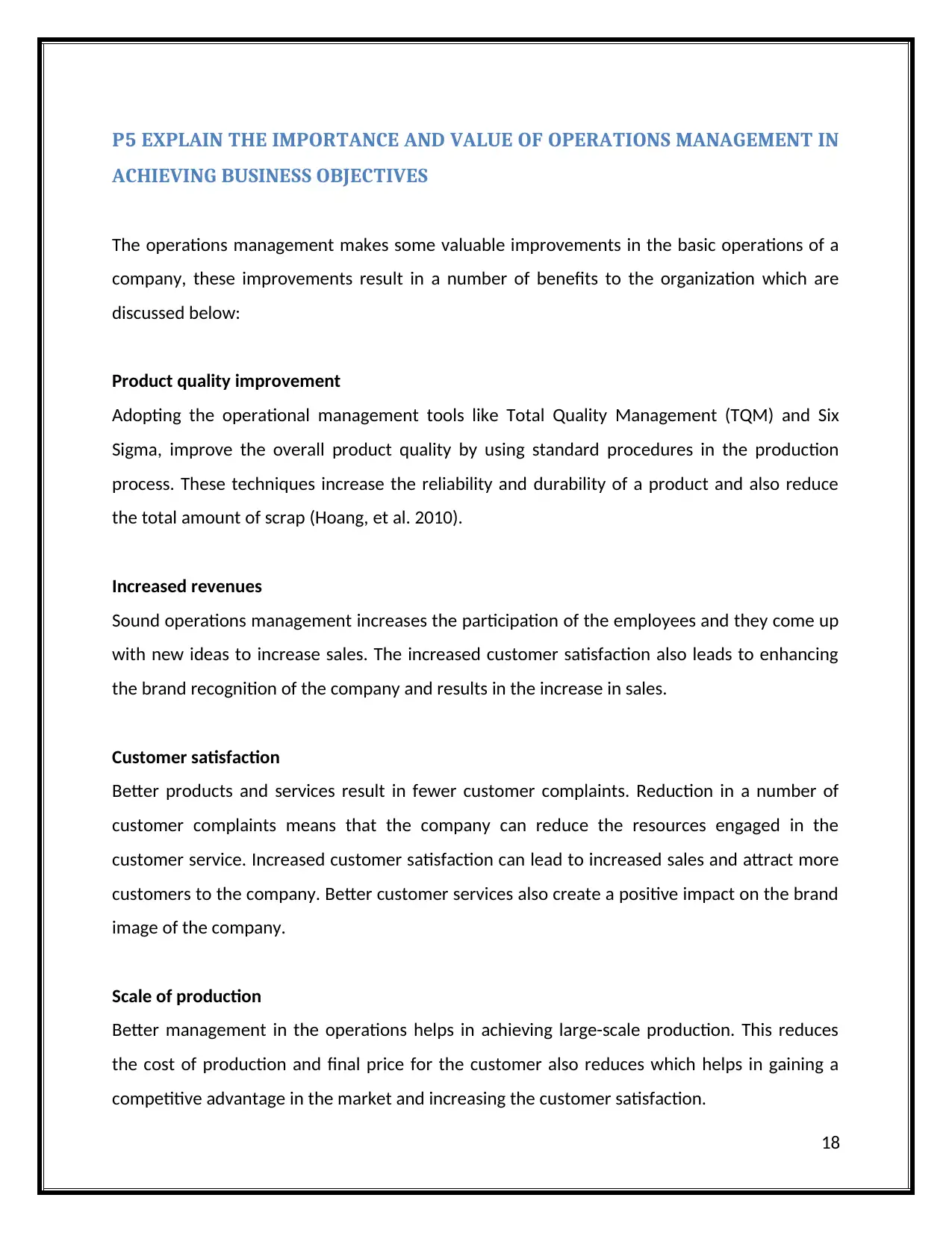
P5 EXPLAIN THE IMPORTANCE AND VALUE OF OPERATIONS MANAGEMENT IN
ACHIEVING BUSINESS OBJECTIVES
The operations management makes some valuable improvements in the basic operations of a
company, these improvements result in a number of benefits to the organization which are
discussed below:
Product quality improvement
Adopting the operational management tools like Total Quality Management (TQM) and Six
Sigma, improve the overall product quality by using standard procedures in the production
process. These techniques increase the reliability and durability of a product and also reduce
the total amount of scrap (Hoang, et al. 2010).
Increased revenues
Sound operations management increases the participation of the employees and they come up
with new ideas to increase sales. The increased customer satisfaction also leads to enhancing
the brand recognition of the company and results in the increase in sales.
Customer satisfaction
Better products and services result in fewer customer complaints. Reduction in a number of
customer complaints means that the company can reduce the resources engaged in the
customer service. Increased customer satisfaction can lead to increased sales and attract more
customers to the company. Better customer services also create a positive impact on the brand
image of the company.
Scale of production
Better management in the operations helps in achieving large-scale production. This reduces
the cost of production and final price for the customer also reduces which helps in gaining a
competitive advantage in the market and increasing the customer satisfaction.
18
ACHIEVING BUSINESS OBJECTIVES
The operations management makes some valuable improvements in the basic operations of a
company, these improvements result in a number of benefits to the organization which are
discussed below:
Product quality improvement
Adopting the operational management tools like Total Quality Management (TQM) and Six
Sigma, improve the overall product quality by using standard procedures in the production
process. These techniques increase the reliability and durability of a product and also reduce
the total amount of scrap (Hoang, et al. 2010).
Increased revenues
Sound operations management increases the participation of the employees and they come up
with new ideas to increase sales. The increased customer satisfaction also leads to enhancing
the brand recognition of the company and results in the increase in sales.
Customer satisfaction
Better products and services result in fewer customer complaints. Reduction in a number of
customer complaints means that the company can reduce the resources engaged in the
customer service. Increased customer satisfaction can lead to increased sales and attract more
customers to the company. Better customer services also create a positive impact on the brand
image of the company.
Scale of production
Better management in the operations helps in achieving large-scale production. This reduces
the cost of production and final price for the customer also reduces which helps in gaining a
competitive advantage in the market and increasing the customer satisfaction.
18
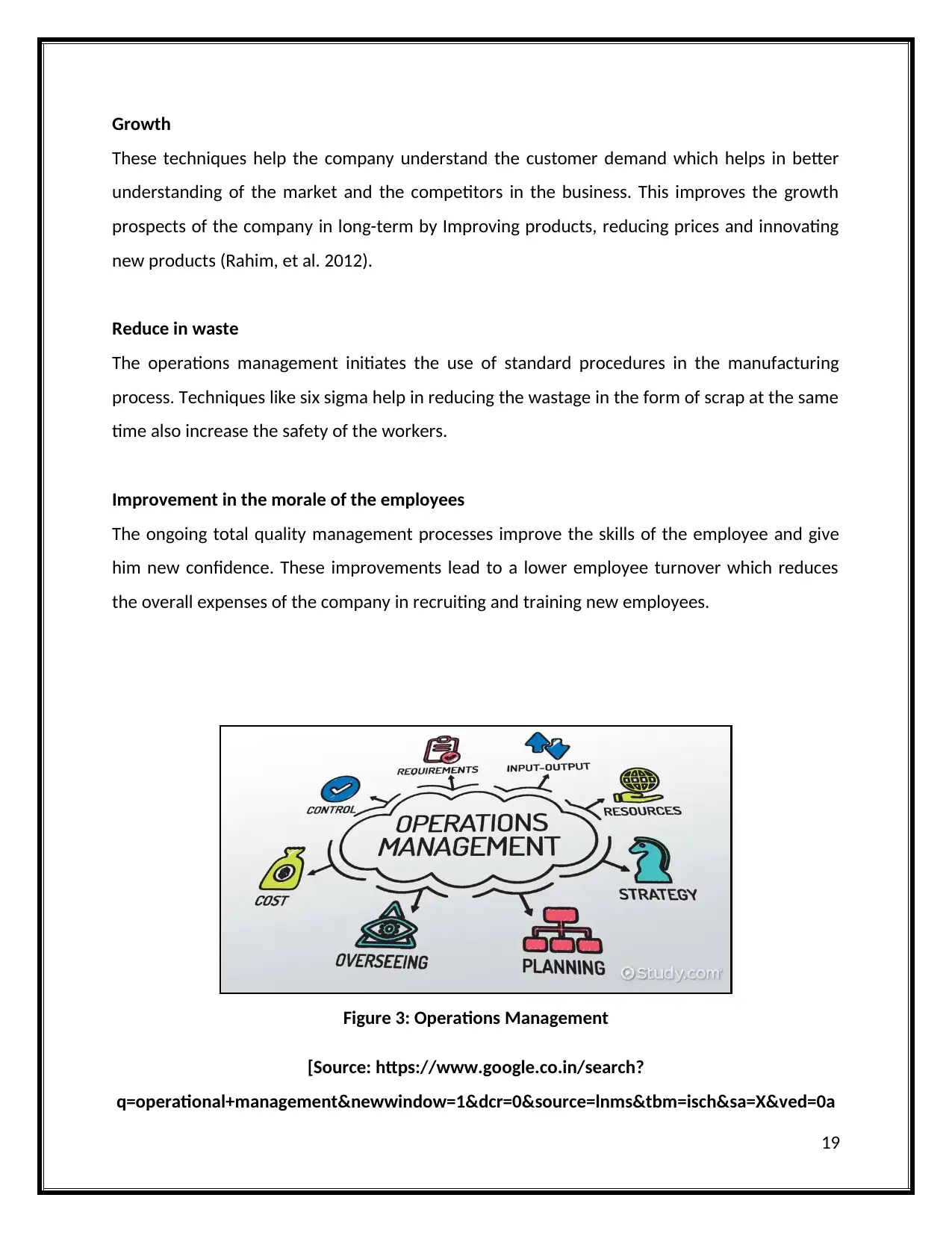
Growth
These techniques help the company understand the customer demand which helps in better
understanding of the market and the competitors in the business. This improves the growth
prospects of the company in long-term by Improving products, reducing prices and innovating
new products (Rahim, et al. 2012).
Reduce in waste
The operations management initiates the use of standard procedures in the manufacturing
process. Techniques like six sigma help in reducing the wastage in the form of scrap at the same
time also increase the safety of the workers.
Improvement in the morale of the employees
The ongoing total quality management processes improve the skills of the employee and give
him new confidence. These improvements lead to a lower employee turnover which reduces
the overall expenses of the company in recruiting and training new employees.
Figure 3: Operations Management
[Source: https://www.google.co.in/search?
q=operational+management&newwindow=1&dcr=0&source=lnms&tbm=isch&sa=X&ved=0a
19
These techniques help the company understand the customer demand which helps in better
understanding of the market and the competitors in the business. This improves the growth
prospects of the company in long-term by Improving products, reducing prices and innovating
new products (Rahim, et al. 2012).
Reduce in waste
The operations management initiates the use of standard procedures in the manufacturing
process. Techniques like six sigma help in reducing the wastage in the form of scrap at the same
time also increase the safety of the workers.
Improvement in the morale of the employees
The ongoing total quality management processes improve the skills of the employee and give
him new confidence. These improvements lead to a lower employee turnover which reduces
the overall expenses of the company in recruiting and training new employees.
Figure 3: Operations Management
[Source: https://www.google.co.in/search?
q=operational+management&newwindow=1&dcr=0&source=lnms&tbm=isch&sa=X&ved=0a
19
Paraphrase This Document
Need a fresh take? Get an instant paraphrase of this document with our AI Paraphraser
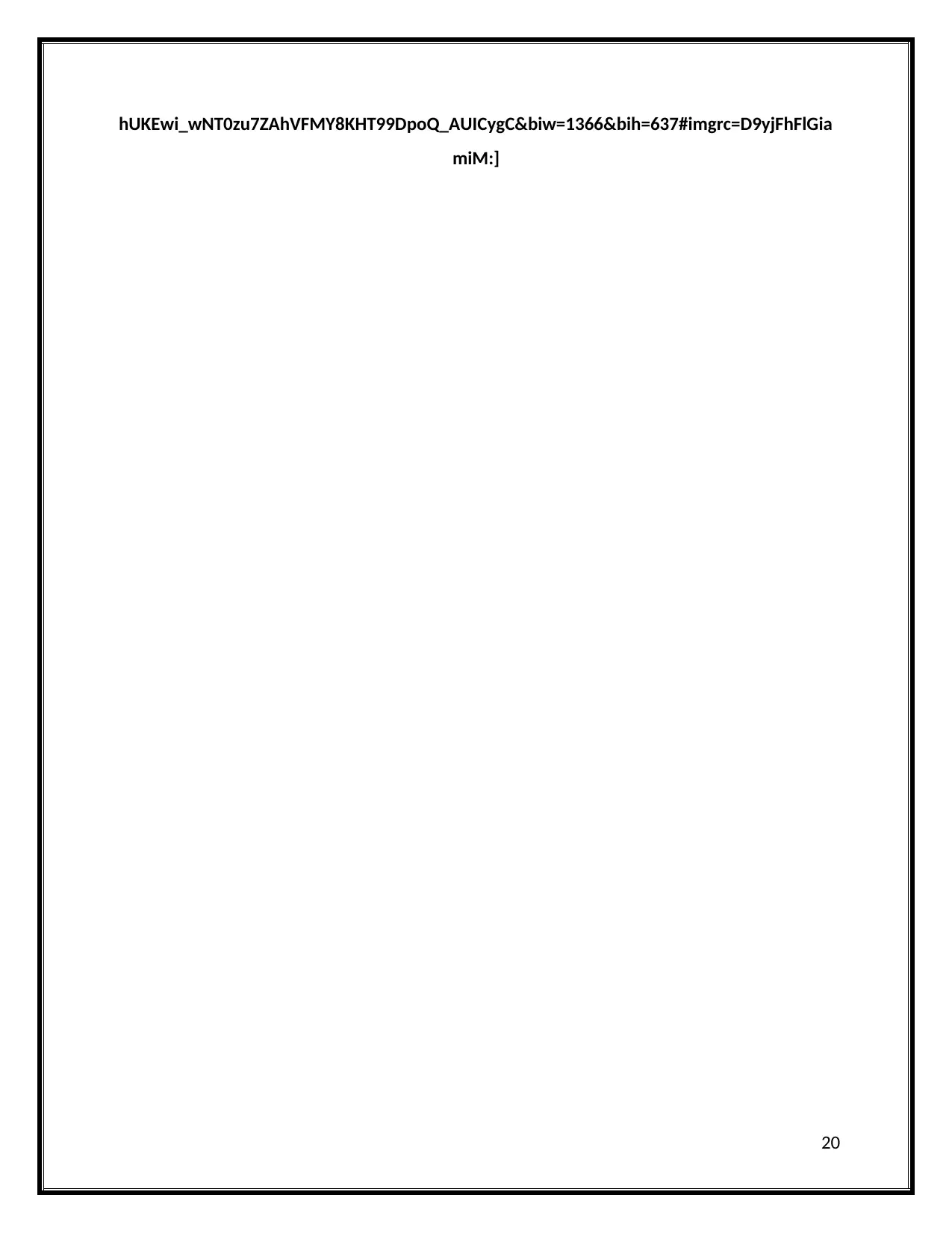
hUKEwi_wNT0zu7ZAhVFMY8KHT99DpoQ_AUICygC&biw=1366&bih=637#imgrc=D9yjFhFlGia
miM:]
20
miM:]
20
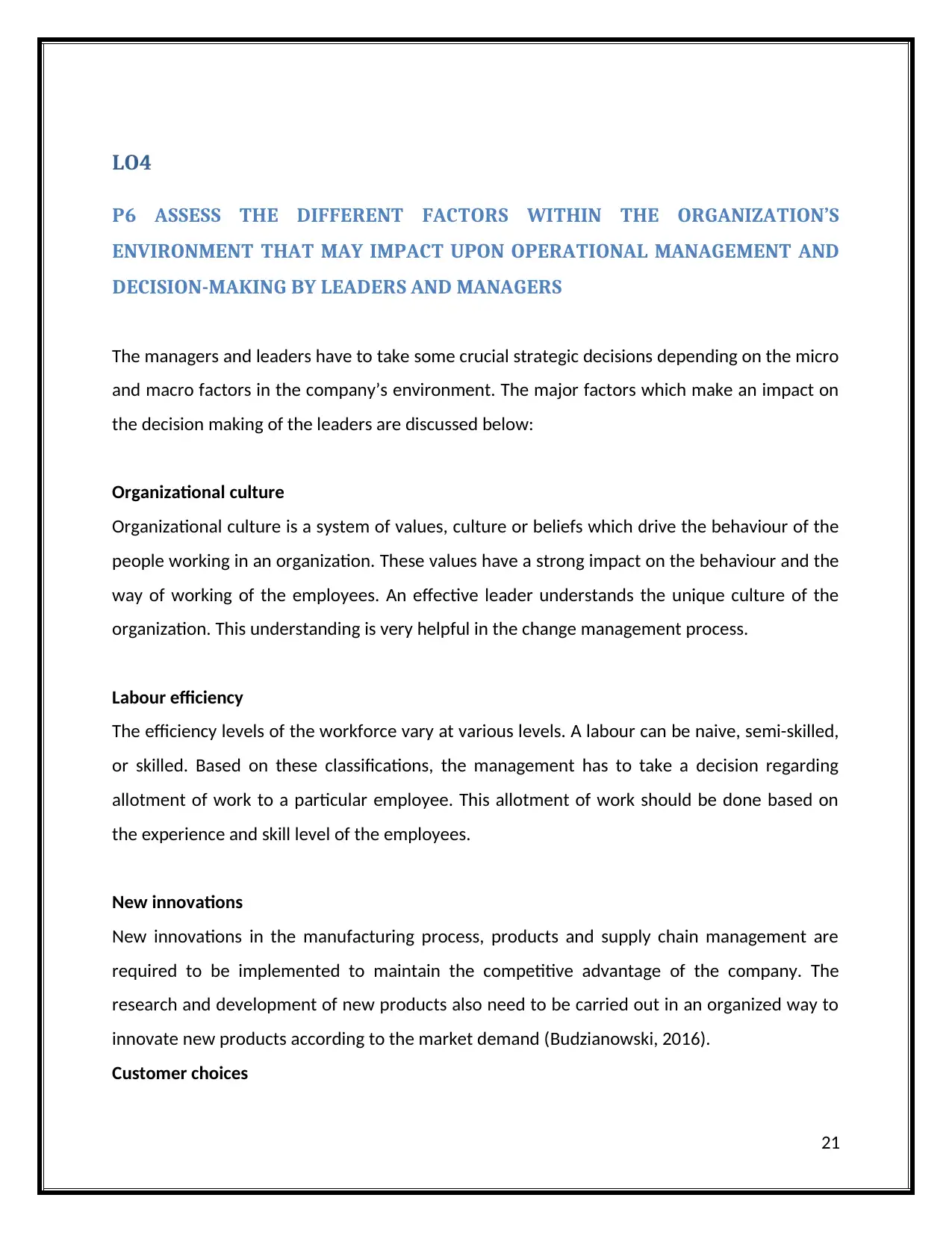
LO4
P6 ASSESS THE DIFFERENT FACTORS WITHIN THE ORGANIZATION’S
ENVIRONMENT THAT MAY IMPACT UPON OPERATIONAL MANAGEMENT AND
DECISION-MAKING BY LEADERS AND MANAGERS
The managers and leaders have to take some crucial strategic decisions depending on the micro
and macro factors in the company’s environment. The major factors which make an impact on
the decision making of the leaders are discussed below:
Organizational culture
Organizational culture is a system of values, culture or beliefs which drive the behaviour of the
people working in an organization. These values have a strong impact on the behaviour and the
way of working of the employees. An effective leader understands the unique culture of the
organization. This understanding is very helpful in the change management process.
Labour efficiency
The efficiency levels of the workforce vary at various levels. A labour can be naive, semi-skilled,
or skilled. Based on these classifications, the management has to take a decision regarding
allotment of work to a particular employee. This allotment of work should be done based on
the experience and skill level of the employees.
New innovations
New innovations in the manufacturing process, products and supply chain management are
required to be implemented to maintain the competitive advantage of the company. The
research and development of new products also need to be carried out in an organized way to
innovate new products according to the market demand (Budzianowski, 2016).
Customer choices
21
P6 ASSESS THE DIFFERENT FACTORS WITHIN THE ORGANIZATION’S
ENVIRONMENT THAT MAY IMPACT UPON OPERATIONAL MANAGEMENT AND
DECISION-MAKING BY LEADERS AND MANAGERS
The managers and leaders have to take some crucial strategic decisions depending on the micro
and macro factors in the company’s environment. The major factors which make an impact on
the decision making of the leaders are discussed below:
Organizational culture
Organizational culture is a system of values, culture or beliefs which drive the behaviour of the
people working in an organization. These values have a strong impact on the behaviour and the
way of working of the employees. An effective leader understands the unique culture of the
organization. This understanding is very helpful in the change management process.
Labour efficiency
The efficiency levels of the workforce vary at various levels. A labour can be naive, semi-skilled,
or skilled. Based on these classifications, the management has to take a decision regarding
allotment of work to a particular employee. This allotment of work should be done based on
the experience and skill level of the employees.
New innovations
New innovations in the manufacturing process, products and supply chain management are
required to be implemented to maintain the competitive advantage of the company. The
research and development of new products also need to be carried out in an organized way to
innovate new products according to the market demand (Budzianowski, 2016).
Customer choices
21
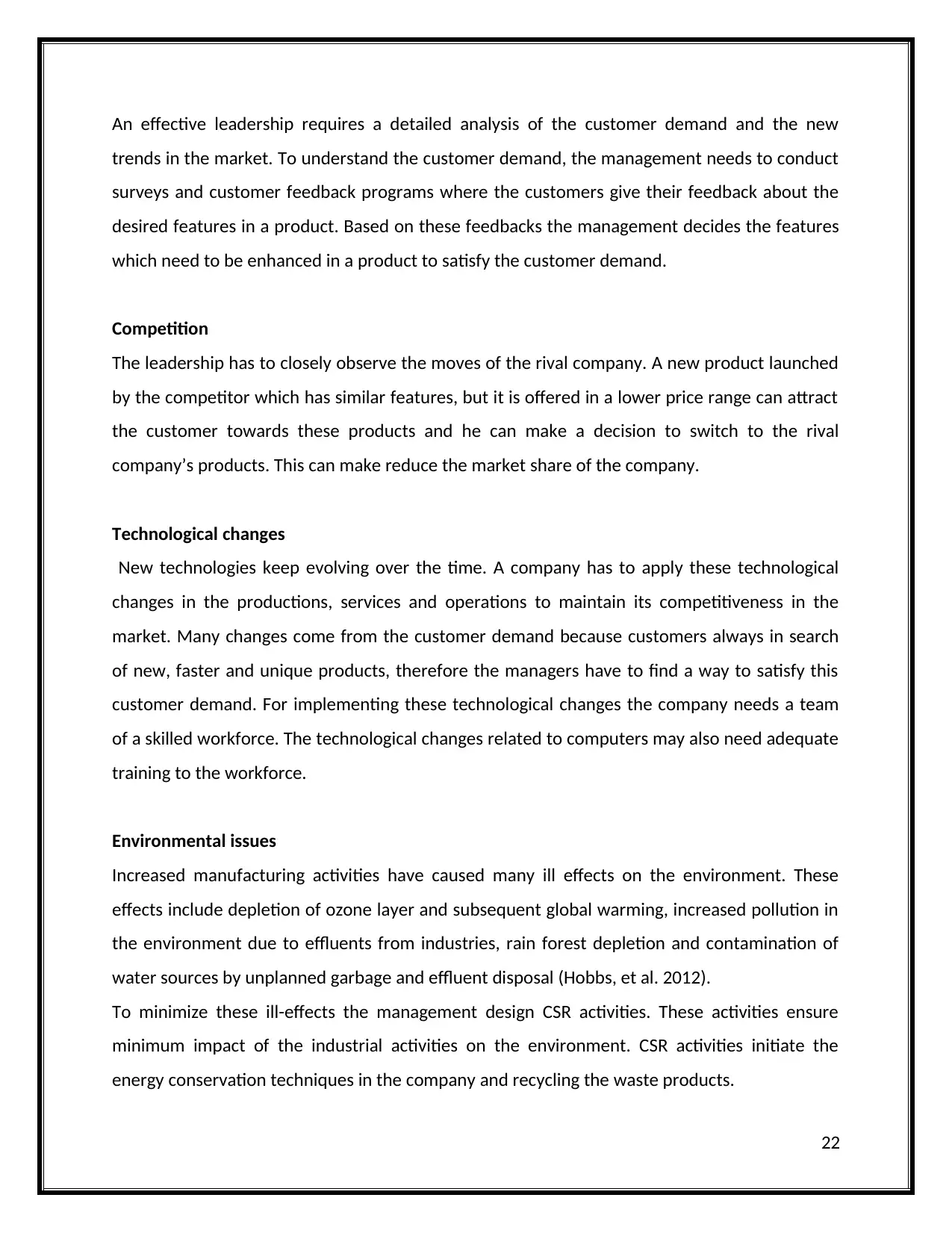
An effective leadership requires a detailed analysis of the customer demand and the new
trends in the market. To understand the customer demand, the management needs to conduct
surveys and customer feedback programs where the customers give their feedback about the
desired features in a product. Based on these feedbacks the management decides the features
which need to be enhanced in a product to satisfy the customer demand.
Competition
The leadership has to closely observe the moves of the rival company. A new product launched
by the competitor which has similar features, but it is offered in a lower price range can attract
the customer towards these products and he can make a decision to switch to the rival
company’s products. This can make reduce the market share of the company.
Technological changes
New technologies keep evolving over the time. A company has to apply these technological
changes in the productions, services and operations to maintain its competitiveness in the
market. Many changes come from the customer demand because customers always in search
of new, faster and unique products, therefore the managers have to find a way to satisfy this
customer demand. For implementing these technological changes the company needs a team
of a skilled workforce. The technological changes related to computers may also need adequate
training to the workforce.
Environmental issues
Increased manufacturing activities have caused many ill effects on the environment. These
effects include depletion of ozone layer and subsequent global warming, increased pollution in
the environment due to effluents from industries, rain forest depletion and contamination of
water sources by unplanned garbage and effluent disposal (Hobbs, et al. 2012).
To minimize these ill-effects the management design CSR activities. These activities ensure
minimum impact of the industrial activities on the environment. CSR activities initiate the
energy conservation techniques in the company and recycling the waste products.
22
trends in the market. To understand the customer demand, the management needs to conduct
surveys and customer feedback programs where the customers give their feedback about the
desired features in a product. Based on these feedbacks the management decides the features
which need to be enhanced in a product to satisfy the customer demand.
Competition
The leadership has to closely observe the moves of the rival company. A new product launched
by the competitor which has similar features, but it is offered in a lower price range can attract
the customer towards these products and he can make a decision to switch to the rival
company’s products. This can make reduce the market share of the company.
Technological changes
New technologies keep evolving over the time. A company has to apply these technological
changes in the productions, services and operations to maintain its competitiveness in the
market. Many changes come from the customer demand because customers always in search
of new, faster and unique products, therefore the managers have to find a way to satisfy this
customer demand. For implementing these technological changes the company needs a team
of a skilled workforce. The technological changes related to computers may also need adequate
training to the workforce.
Environmental issues
Increased manufacturing activities have caused many ill effects on the environment. These
effects include depletion of ozone layer and subsequent global warming, increased pollution in
the environment due to effluents from industries, rain forest depletion and contamination of
water sources by unplanned garbage and effluent disposal (Hobbs, et al. 2012).
To minimize these ill-effects the management design CSR activities. These activities ensure
minimum impact of the industrial activities on the environment. CSR activities initiate the
energy conservation techniques in the company and recycling the waste products.
22
Secure Best Marks with AI Grader
Need help grading? Try our AI Grader for instant feedback on your assignments.
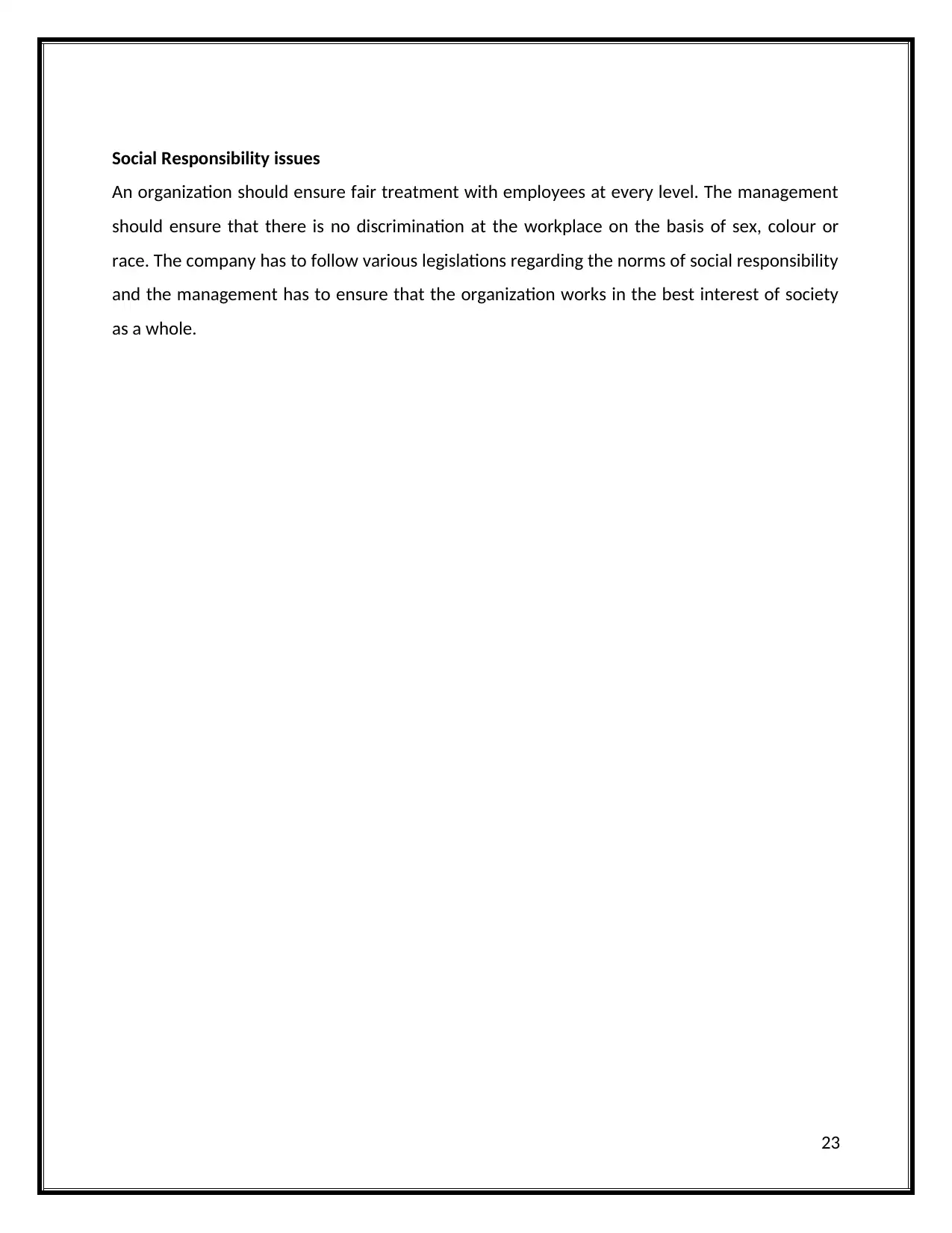
Social Responsibility issues
An organization should ensure fair treatment with employees at every level. The management
should ensure that there is no discrimination at the workplace on the basis of sex, colour or
race. The company has to follow various legislations regarding the norms of social responsibility
and the management has to ensure that the organization works in the best interest of society
as a whole.
23
An organization should ensure fair treatment with employees at every level. The management
should ensure that there is no discrimination at the workplace on the basis of sex, colour or
race. The company has to follow various legislations regarding the norms of social responsibility
and the management has to ensure that the organization works in the best interest of society
as a whole.
23
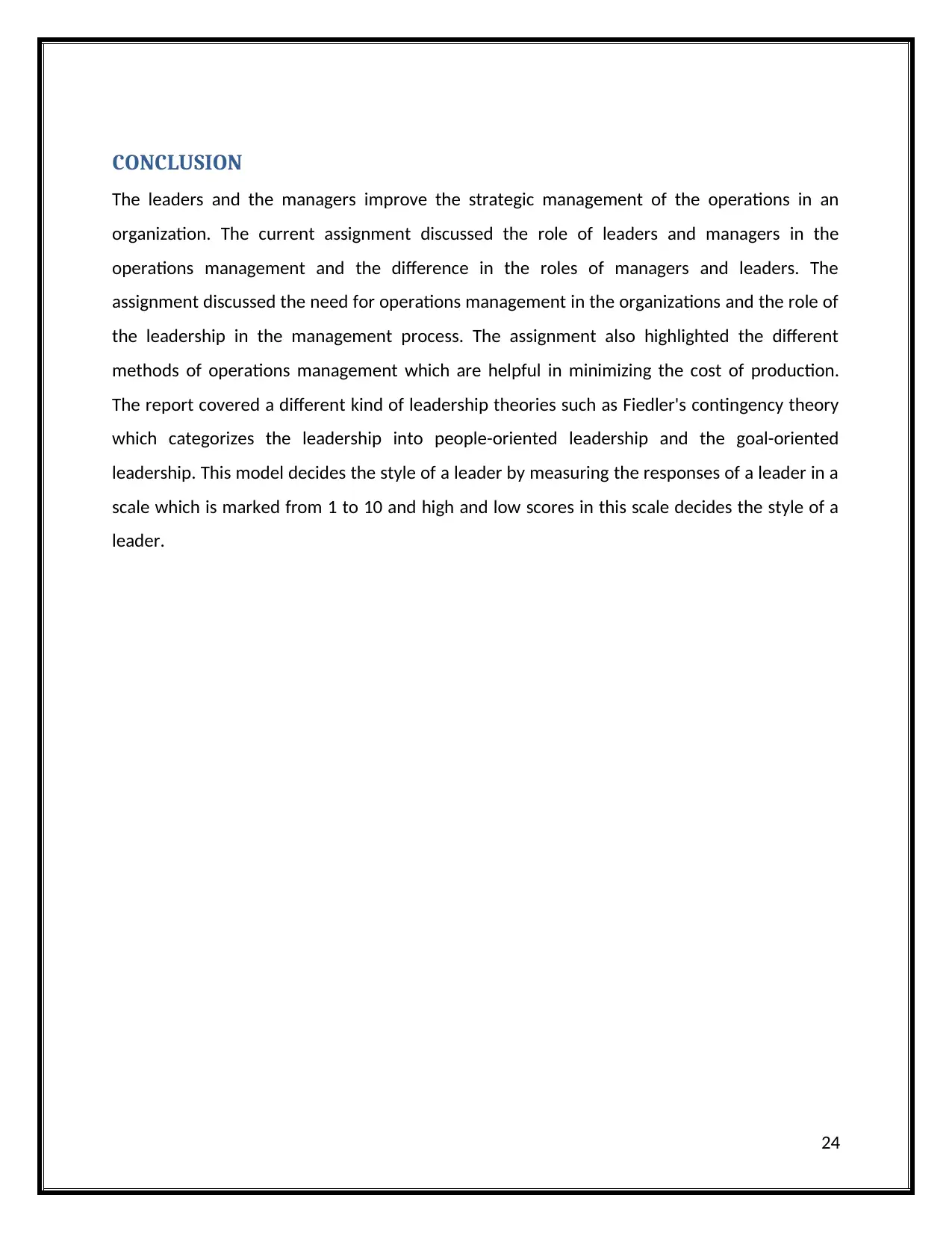
CONCLUSION
The leaders and the managers improve the strategic management of the operations in an
organization. The current assignment discussed the role of leaders and managers in the
operations management and the difference in the roles of managers and leaders. The
assignment discussed the need for operations management in the organizations and the role of
the leadership in the management process. The assignment also highlighted the different
methods of operations management which are helpful in minimizing the cost of production.
The report covered a different kind of leadership theories such as Fiedler's contingency theory
which categorizes the leadership into people-oriented leadership and the goal-oriented
leadership. This model decides the style of a leader by measuring the responses of a leader in a
scale which is marked from 1 to 10 and high and low scores in this scale decides the style of a
leader.
24
The leaders and the managers improve the strategic management of the operations in an
organization. The current assignment discussed the role of leaders and managers in the
operations management and the difference in the roles of managers and leaders. The
assignment discussed the need for operations management in the organizations and the role of
the leadership in the management process. The assignment also highlighted the different
methods of operations management which are helpful in minimizing the cost of production.
The report covered a different kind of leadership theories such as Fiedler's contingency theory
which categorizes the leadership into people-oriented leadership and the goal-oriented
leadership. This model decides the style of a leader by measuring the responses of a leader in a
scale which is marked from 1 to 10 and high and low scores in this scale decides the style of a
leader.
24
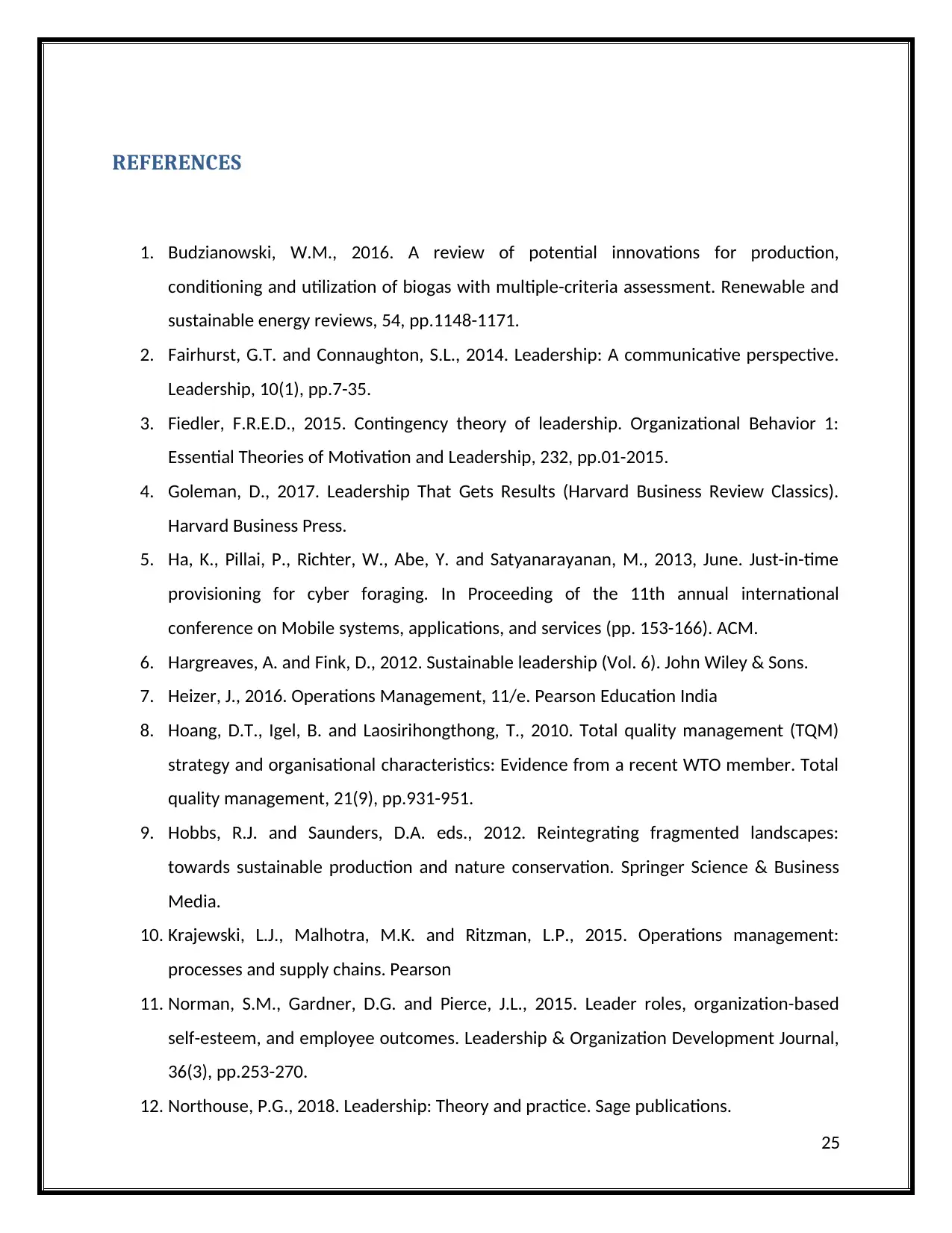
REFERENCES
1. Budzianowski, W.M., 2016. A review of potential innovations for production,
conditioning and utilization of biogas with multiple-criteria assessment. Renewable and
sustainable energy reviews, 54, pp.1148-1171.
2. Fairhurst, G.T. and Connaughton, S.L., 2014. Leadership: A communicative perspective.
Leadership, 10(1), pp.7-35.
3. Fiedler, F.R.E.D., 2015. Contingency theory of leadership. Organizational Behavior 1:
Essential Theories of Motivation and Leadership, 232, pp.01-2015.
4. Goleman, D., 2017. Leadership That Gets Results (Harvard Business Review Classics).
Harvard Business Press.
5. Ha, K., Pillai, P., Richter, W., Abe, Y. and Satyanarayanan, M., 2013, June. Just-in-time
provisioning for cyber foraging. In Proceeding of the 11th annual international
conference on Mobile systems, applications, and services (pp. 153-166). ACM.
6. Hargreaves, A. and Fink, D., 2012. Sustainable leadership (Vol. 6). John Wiley & Sons.
7. Heizer, J., 2016. Operations Management, 11/e. Pearson Education India
8. Hoang, D.T., Igel, B. and Laosirihongthong, T., 2010. Total quality management (TQM)
strategy and organisational characteristics: Evidence from a recent WTO member. Total
quality management, 21(9), pp.931-951.
9. Hobbs, R.J. and Saunders, D.A. eds., 2012. Reintegrating fragmented landscapes:
towards sustainable production and nature conservation. Springer Science & Business
Media.
10. Krajewski, L.J., Malhotra, M.K. and Ritzman, L.P., 2015. Operations management:
processes and supply chains. Pearson
11. Norman, S.M., Gardner, D.G. and Pierce, J.L., 2015. Leader roles, organization-based
self-esteem, and employee outcomes. Leadership & Organization Development Journal,
36(3), pp.253-270.
12. Northouse, P.G., 2018. Leadership: Theory and practice. Sage publications.
25
1. Budzianowski, W.M., 2016. A review of potential innovations for production,
conditioning and utilization of biogas with multiple-criteria assessment. Renewable and
sustainable energy reviews, 54, pp.1148-1171.
2. Fairhurst, G.T. and Connaughton, S.L., 2014. Leadership: A communicative perspective.
Leadership, 10(1), pp.7-35.
3. Fiedler, F.R.E.D., 2015. Contingency theory of leadership. Organizational Behavior 1:
Essential Theories of Motivation and Leadership, 232, pp.01-2015.
4. Goleman, D., 2017. Leadership That Gets Results (Harvard Business Review Classics).
Harvard Business Press.
5. Ha, K., Pillai, P., Richter, W., Abe, Y. and Satyanarayanan, M., 2013, June. Just-in-time
provisioning for cyber foraging. In Proceeding of the 11th annual international
conference on Mobile systems, applications, and services (pp. 153-166). ACM.
6. Hargreaves, A. and Fink, D., 2012. Sustainable leadership (Vol. 6). John Wiley & Sons.
7. Heizer, J., 2016. Operations Management, 11/e. Pearson Education India
8. Hoang, D.T., Igel, B. and Laosirihongthong, T., 2010. Total quality management (TQM)
strategy and organisational characteristics: Evidence from a recent WTO member. Total
quality management, 21(9), pp.931-951.
9. Hobbs, R.J. and Saunders, D.A. eds., 2012. Reintegrating fragmented landscapes:
towards sustainable production and nature conservation. Springer Science & Business
Media.
10. Krajewski, L.J., Malhotra, M.K. and Ritzman, L.P., 2015. Operations management:
processes and supply chains. Pearson
11. Norman, S.M., Gardner, D.G. and Pierce, J.L., 2015. Leader roles, organization-based
self-esteem, and employee outcomes. Leadership & Organization Development Journal,
36(3), pp.253-270.
12. Northouse, P.G., 2018. Leadership: Theory and practice. Sage publications.
25
Paraphrase This Document
Need a fresh take? Get an instant paraphrase of this document with our AI Paraphraser
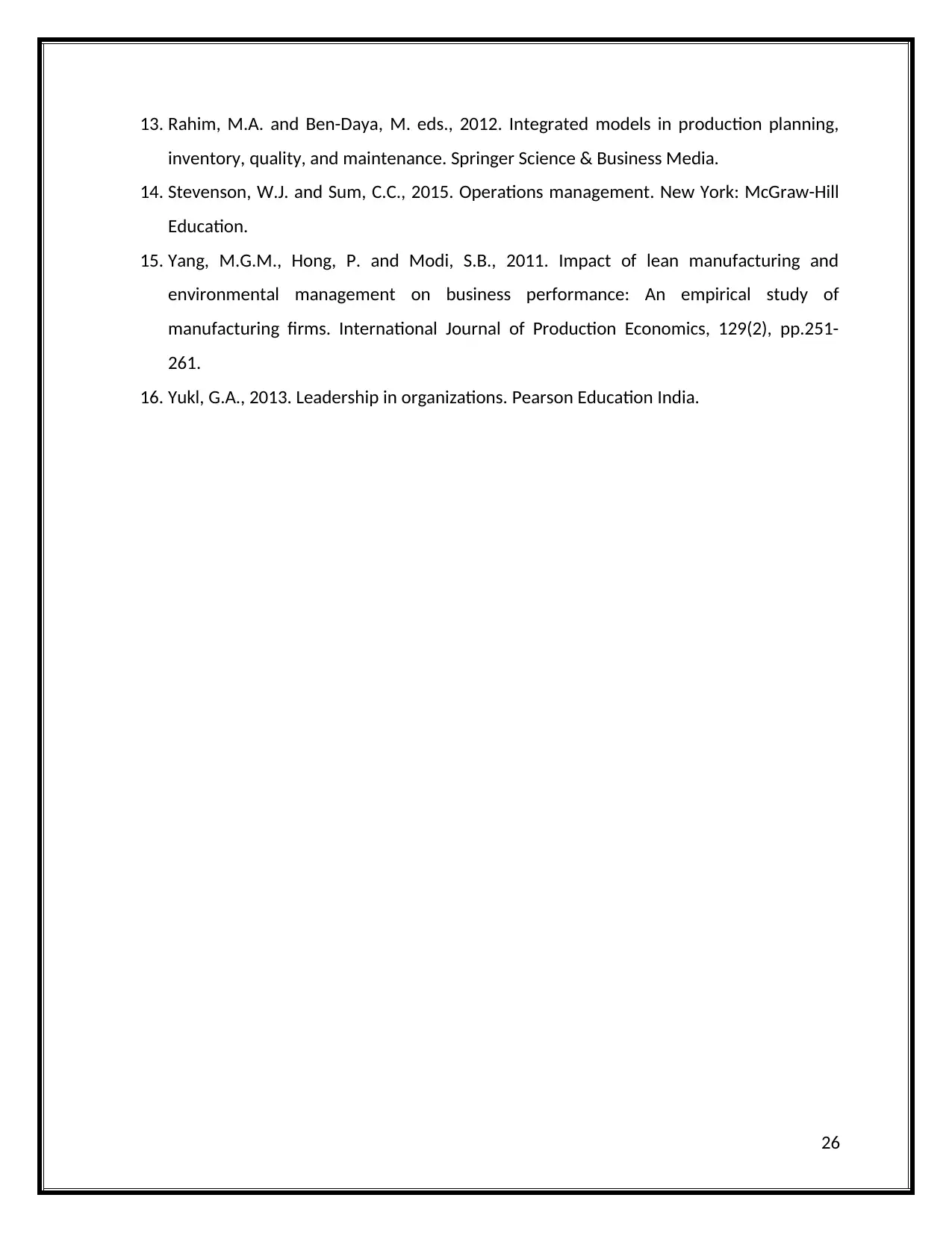
13. Rahim, M.A. and Ben-Daya, M. eds., 2012. Integrated models in production planning,
inventory, quality, and maintenance. Springer Science & Business Media.
14. Stevenson, W.J. and Sum, C.C., 2015. Operations management. New York: McGraw-Hill
Education.
15. Yang, M.G.M., Hong, P. and Modi, S.B., 2011. Impact of lean manufacturing and
environmental management on business performance: An empirical study of
manufacturing firms. International Journal of Production Economics, 129(2), pp.251-
261.
16. Yukl, G.A., 2013. Leadership in organizations. Pearson Education India.
26
inventory, quality, and maintenance. Springer Science & Business Media.
14. Stevenson, W.J. and Sum, C.C., 2015. Operations management. New York: McGraw-Hill
Education.
15. Yang, M.G.M., Hong, P. and Modi, S.B., 2011. Impact of lean manufacturing and
environmental management on business performance: An empirical study of
manufacturing firms. International Journal of Production Economics, 129(2), pp.251-
261.
16. Yukl, G.A., 2013. Leadership in organizations. Pearson Education India.
26
1 out of 26
Related Documents
Your All-in-One AI-Powered Toolkit for Academic Success.
+13062052269
info@desklib.com
Available 24*7 on WhatsApp / Email
![[object Object]](/_next/static/media/star-bottom.7253800d.svg)
Unlock your academic potential
© 2024 | Zucol Services PVT LTD | All rights reserved.





